
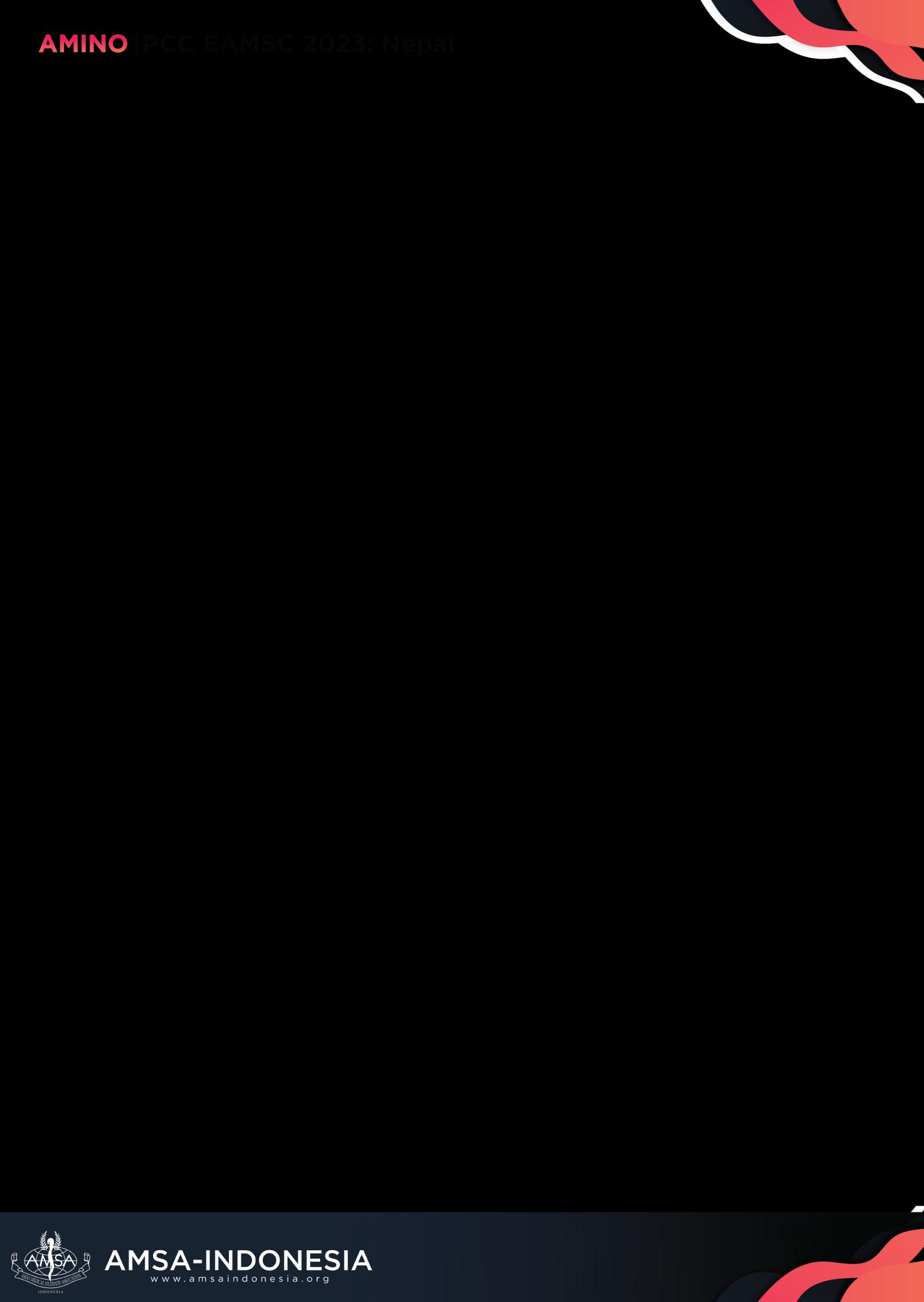
• • • •

• • • • •

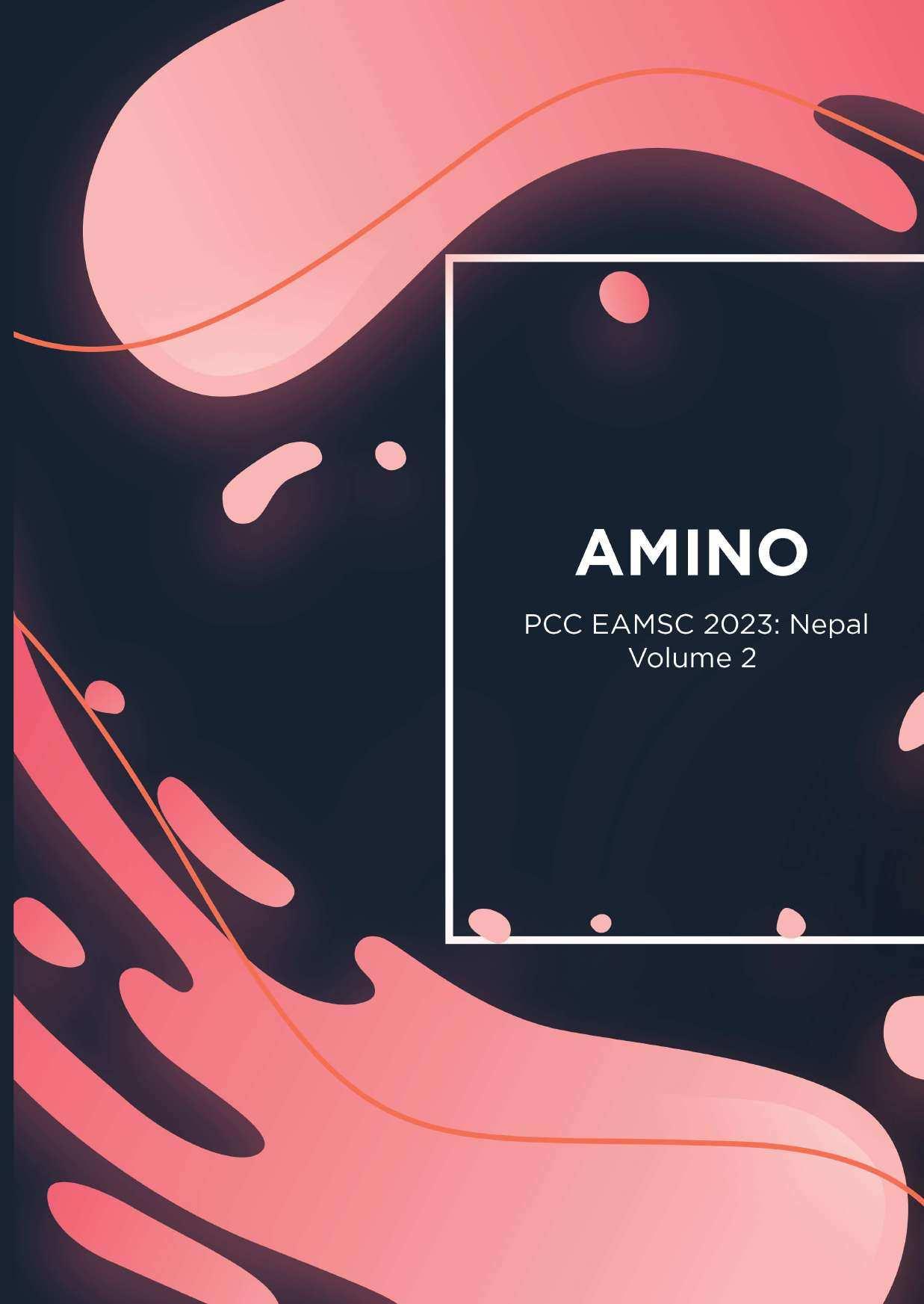
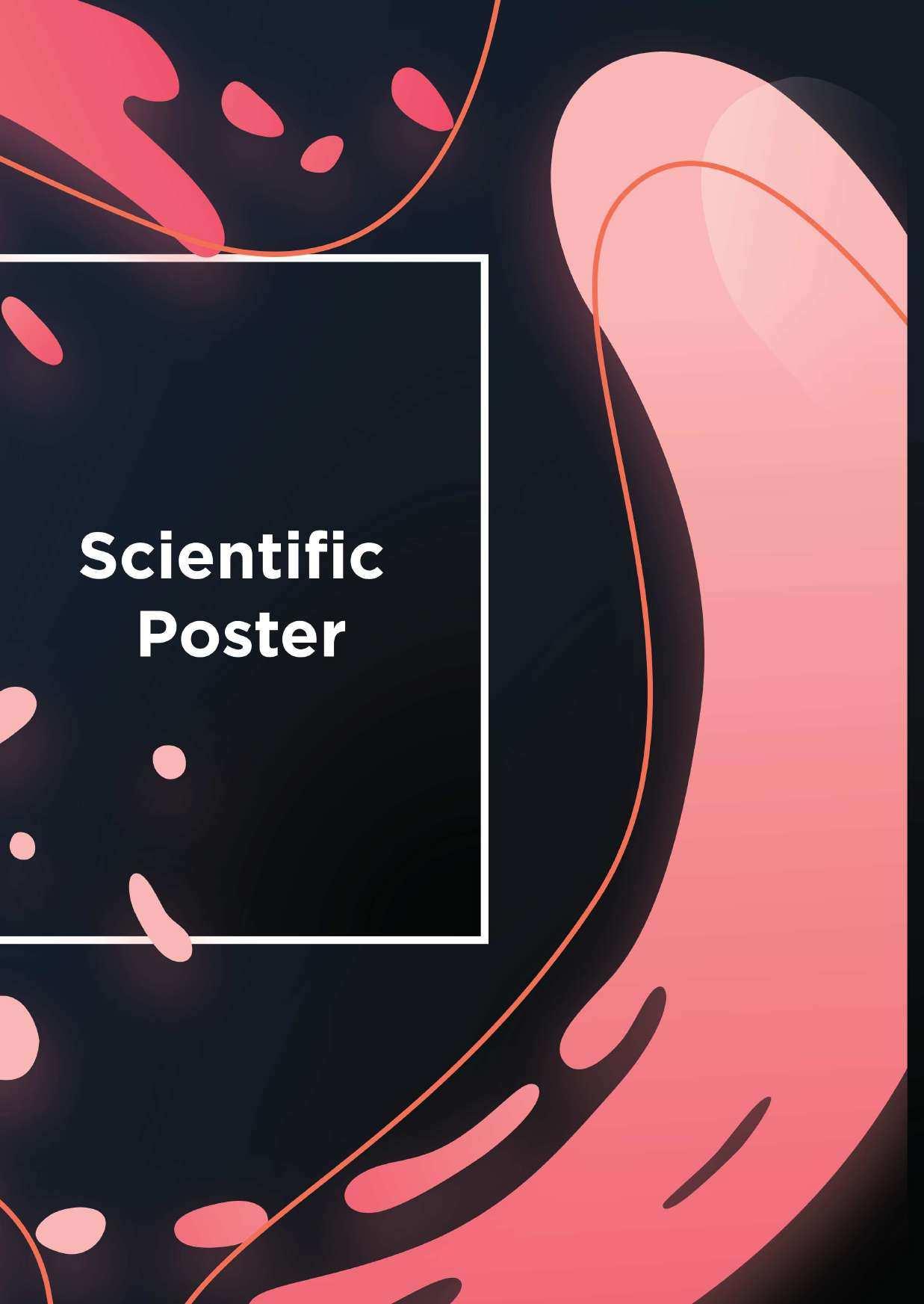


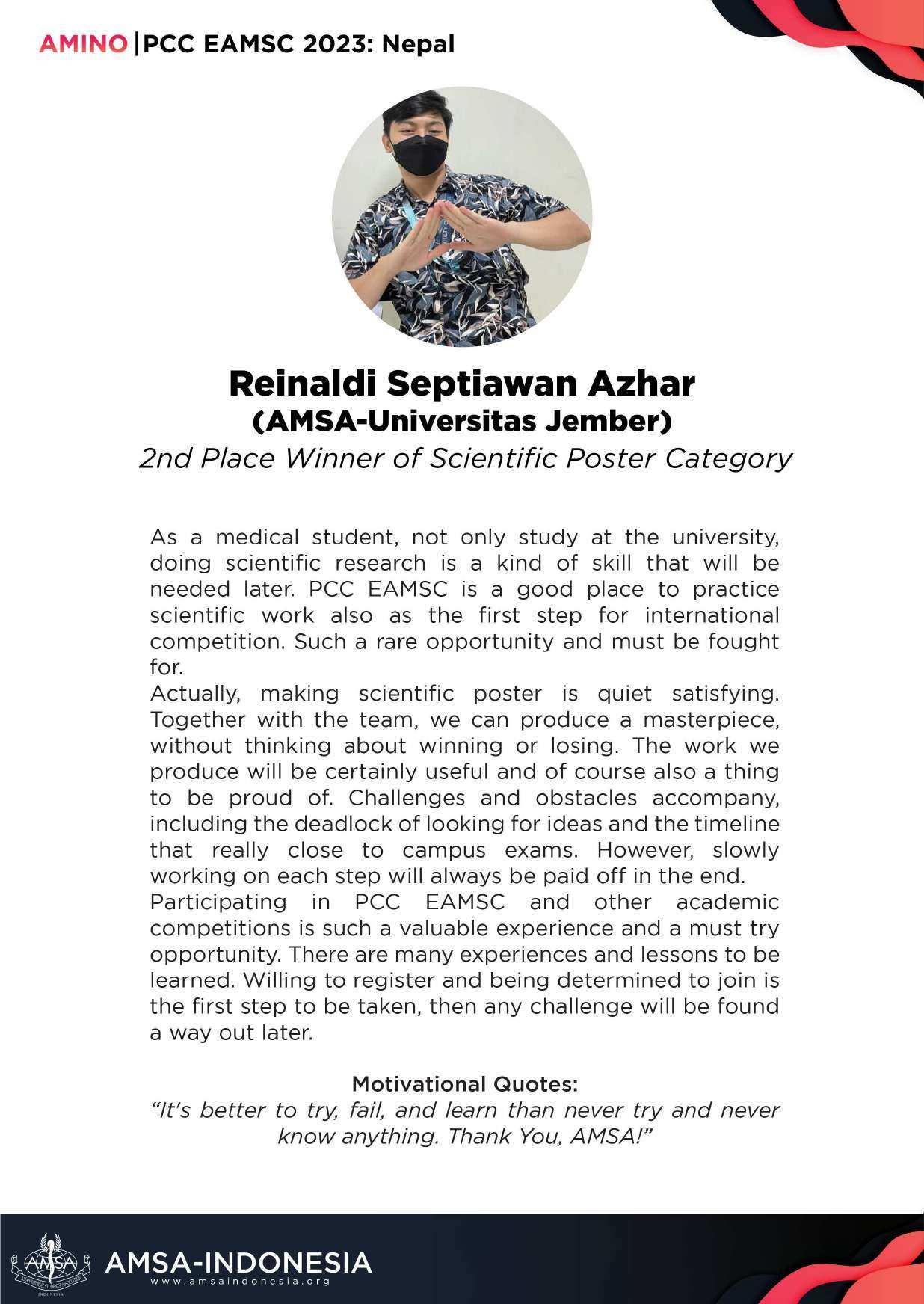

Effectiveness of nanoparticles dressing for wound management: A Systematic Review and Meta-Analysis of Randomized Controlled Trials
Introduction: Dressings that promote moist and wound healing are required for the treatment of the majority of wounds. When wound healing does not progress normally, a chronic wound may result. Studies report that about 15% of chronic wounds remain unsolvable after 1 year of presentation. This is because inadequate use or incorrect of dressings could be the factor impacting the healing progression. Technological advancement in nanomaterials gives rise to many properties of wound management such as antibacterial agents, antibiotic nanocarrier and scaffolding formation.
Objective: This systematic review and meta-analysis is aimed to investigate the effectiveness of nanoparticles dressing on wound management.
Methods: This study followed guidelines provided by PRISMA. A literature search was conducted with multiple electronic databases. The risk of biases was assessed for each study using Risk of Bias (RoB) 2.0. Meta-analysis was performed using a random or fixed-effect model based on the heterogeneity. Mean and Standard Deviation (SD) with the confidence interval (CI) of 95% were used to determine the association between nanoparticles dressing and the outcomes.
Results: Nanoparticle dressing affects the wound healing time, pain level, and odour score. This meta-analysis suggested an intervention of nanoparticles dressing showed to have more effect on decreasing pain when compared to control (pooled MD= -2.20, 95% CI (-4.390,22),p=0.05,I2=97%). Anotherresultofourmeta-analysishasalsoshownthatwoundhealing time is not significant when compared to control (pooled MD= -1.36 95% CI ( 3.02, 0.30), p= 0.11 I²=97%)
Conclusion: This study showed evidence of the effect of nanoparticles dressing in wound management, significantly in decrease level of pain.
Keywords: Dressing, Nanoparticles, Wound
Reinaldi Septiawan Azhar, Fitranda Kusiyanto Taslim, Stefia Aisyah Amini, Putu Julio Adriana

with CVD 103-HgR Oral Cholera Vaccine: A Systematic Review and Meta-Analysis
[Correspondence E-mail: sebastiansudiasa@gmail.com]
ABSTRACT
Introduction
Cholera is an acute diarrheal illness that remains a public health problemin more than 50 developing countries with 4 million cases globally every year, primarily attacking unprivileged populations, and responsible for over 140,000 fatalities. Due to its fatality and severityofsymptoms, oral cholera vaccination (OCV) was promoted as a preventive action in people traveling to cholera-endemic areas. CVD 103-HgR, a live attenuated oral cholera vaccine, was recommended, since it could potentially improve serum vibriocidal antibodies (SVAs) produced by natural or experimental Vibrio cholerae infection, providing protection against cholera.
Objective
To assess the efficacyof oral cholera vaccine for improving immunityagainst cholera infection, specificallyantibodies seroconversion rate, in tropical countries.
Methods
The studies included were obtained by performing a literature search in 5 databases, namely PubMed, Science Direct, EBSCOhost, Cochrane Library, and Google Scholar, then assessed according to the PRISMA flow diagram, resulting in 13 studies for quantitative analysis. Risk of bias was assessed using the Cochrane risk-of-bias tool for randomized controlled trials (RoB2).
Results andDiscussion
Thirteen studies were included in this study. We found that CVD 103-HgR OCV is effective to improve SVA. Thus, offer protection against cholera infection (Risk Ratio 22.35 [95% CI: 12.49 - 40.01, P < 0.00001]). CVD 103-HgR OCV also has been shown to significantly increase anti-CT antibody GMT (geometric mean titer), resulting in increasing immunogenicity. However, the data obtained shows heterogeneity(荊態> 40%).
Conclusion
CVD 103-HgR OCVsignificantly and robustly improved the SVAseroconversion rate as a prevention against cholera. CVD 103-HgR OCV is an excellent choice for preventive action against cholera disease. However, higher-quality studies are required to examine the adverse effect ofCVD103-HgROCV. Thus, CVD 103-HgROCVneeds to beincluded in health policies in cholera-endemic countries.
Keywords: oral cholera vaccine, prevention, vibrio cholerae, traveling
Save Your Trip, Save Your Smile
I Nyoman Sebastian Sudiasa, Eisya Akmel Naila, Mohammad Satrio Wicaksono, Bela Amru Hakiki

Retinopathy as Clinical Predictor for Cerebral Malaria in Tropical and Underdeveloped Regions: A Systematic Review and Meta-Analysis
Background:
Cerebral malaria is a disease caused by infection of parasite Plasmodium falciparum which is obtained from the bite of a female Anopheles mosquito. Retinopathy has a significant association with the incidence of cerebral malaria, therefore it can be used to predict the outcome of cerebral malaria in tropical countries.
Objective/aim: This systematic review and meta-analysis aimed to assess retinopathy as a prognostic finding in cerebral malaria.
Method: This meta-analysis assessed observational studies. A comprehensive literature search was performed in Pubmed, Plos One, Proquest, EBSCO Essentials, ScienceDirect, and Google Scholar (Boolean operator). Review Manager 5.4.1 with Mantel Haenszel method was utilized to analyze the data extraction and methodological index was utilized to assess the risk of bias from the included studies i.e cerebral malaria patient compared to non-cerebral malaria, direct and indirect ophthalmoscopy, with the outcome is retinopathy positive. Odd Ratio is calculated with Confidence Interval of 95%. P<0.05 was considered significant.
Result:
Eleven observational studies with a total number 2.009 participants were included. Authors use 545 samples for quantitative analysis. We found that there is a low risk of bias and a significant differencebetweenthecontrolgroupand the casegroup;cerebralmalariaandnon-cerebralmalaria (Fixed effect, OR 1.88 ; 95% CI 1.23 to 2.87 ; P = 0.003).
Conclusion:
Results of this systematic review and meta-analysis demonstrated that retinopathy is an important finding to rule in severe and cerebral malaria diagnosis as it shows a pathophysiological significance associated with compromised microcirculation.
Keywords:
Cerebral malaria, retinopathy, prognosis.
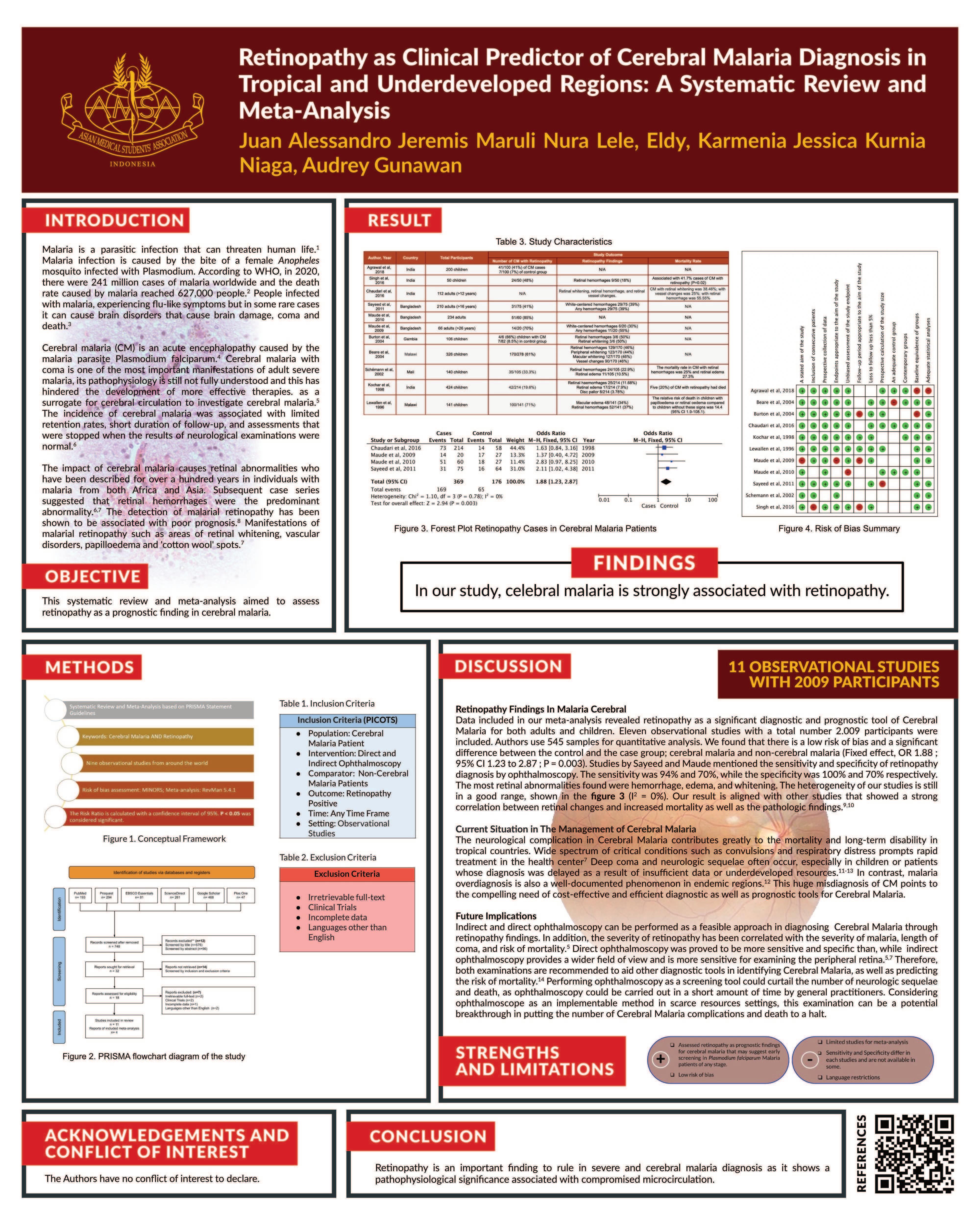
Effectiveness of Ibuprofen andAcetazolamide in PreventingAcute Mountain Sickness: AMeta-Analysis of Randomized Controlled Trials
Fan MaitriAldian, Maxwell Salvador SuryaAtmaja, Melissa ValentinaAriyanto, Visuddho
Introduction: Acutemountainsickness(AMS)isthemostcommontypeofhigh-altitude illnesscausedbyhypoxia,possiblyleadingtofatalitycircumstancessuchaspulmonaryand cerebral edema.Acetazolamide and Ibuprofen have both shown efficacy forAMS prevention.
Objective: Thismeta-analysisaimedtoinvestigatetheeffectivenessofAcetazolamideand Ibuprofen in reducing the likelihood ofAMS and headache.
Methods: AsystematicliteraturesearchwasconductedbyPRISMA2020guidelineson severaldatabases.StudyqualitywasassessedusingtheCochrane’sRiskofBias2tool.AMS andheadachewereusedastheoutcomemeasures.Publicationbiaswasevaluatedusing funnel plot.
Results: Tenrandomizedcontrolledtrialswithatotalof1475highaltitudetravelers(522 receivedAcetazolamide,371receivedIbuprofen,and582receivedPlacebo)wereincluded. Mostofthestudiesareofhighquality.BothofAcetazolamide125mg,250mg,and IbuprofenhadacaneffectivelyreducethelikelihoodtopresentAMSwithOR(0.48;95%CI 0.30-0.77; p =0.78vs0.27;95%CI0.15-0.49; p =0.92vs0.45;95%CI0.31-0.66; p =0.87, respectively)anddecreasingthelikelihoodtoheadachewithOR(0.45;95%CI0.33-0.62; p =0.57vs0.22;95%CI0.14-0.35; p =0.38vs0.53;95%CI0.35-0.80; p=0.38)ofhigh altitude travelers compared with the control group. No publication bias was found.
Conclusion: AcetazolamideandIbuprofenareeffectiveinreducingthelikelihoodofAMS andheadache.AcetazolamidehaveabetterefficacyandaffordabilitythanIbuprofen,but Ibuprofenhasamilderadverseeffect.Furtherresearchonthegrowingevidenceand developmentofthedifferencebetweenAcetazolamideandIbuprofenthroughlarge-scale controlled trials are warranted to corroborate our findings.
Keywords: Acetazolamide, Ibuprofen, High Altitude,Acute Mountain Sickness, Headache
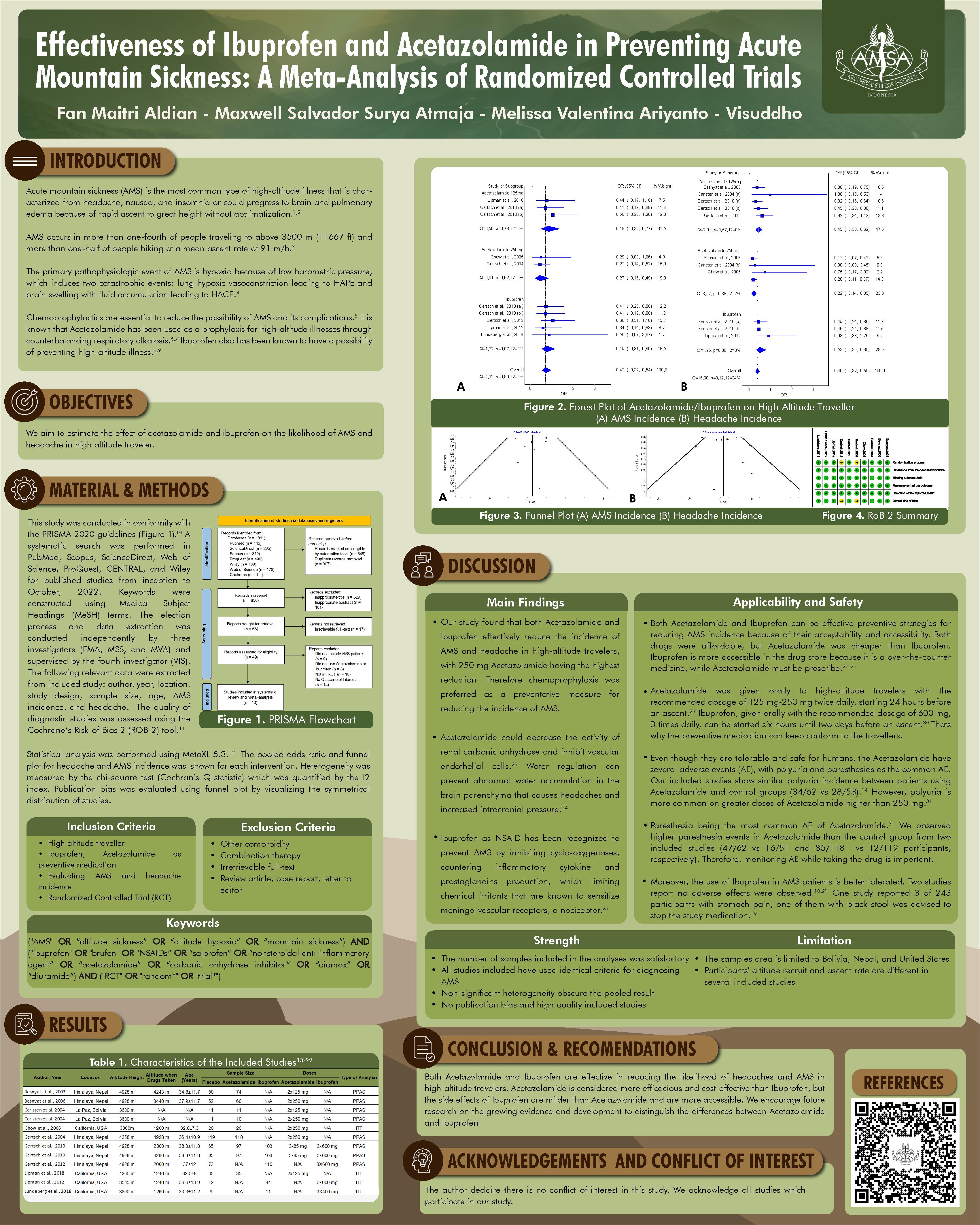
IS THERE ANY EFFICACY OF RIBAVIRIN AS A PROMISING TREATMENT FOR EMERGING HEPATITIS E? :
A SYSTEMATIC REVIEW AND META-ANALYSIS
Derren David C.H. Rampengan, Natasha Cita Paradhita Kusuma, Nabilah Puteri Larassaphira, Felicia Angelica Gunawan
AMSA-Universitas Sam Ratulangi, AMSA-Universitas Tarumanagara, AMSAUniversitas Hassanudin
Introduction: Hepatitis E Virus (HEV) is the most common cause of epidemics, sporadic infections, and outbreaks among developing countries, especially in Nepal. In 2022, HEV infection rates worldwide are estimated at 20 million per year; nearly 70.000 people die from these diseases each year. Immunocompromised hepatitis E patientscandevelopchronichepatitisE. Thehighmorbidityand mortalityrates(>20%) urge the need for possible treatment. The research discovered that both acute and chronic HEV canbe treated withribavirin. Asystematic review and meta-analysis were conducted to summarize the potential for reducing future outbreaks of HEV in humans by exploring efficacy and safety evidence
Objective : To explore the efficacy of ribavirin as a potential treatment for Hepatitis E
Methods: Data were collected through PubMed, Clinicalkey, and ScienceDirect, from 2017-2022 regarding the usage of Ribavirin for hepatitis E patients. A meta-analysis was conducted, which asses the data extracted from resulting in 10 studies that were included; risk of bias assessment were assessed based on the Newcastle-Ottawa Scale (NOS).
Results: This study yielded 10 studies witha total491 patients identified and about 445 patients were treated with ribavirin. Estimated treatment results show effect after the administration of ribavirin treatment of 73% (Mean difference (MD) = 0.73; 95% CI: 0.63-0.84). The heterogeneity between the studies was substantial (I2=69%; P<0.01). Indeed, ribavirin efficacy was found to significantly provide a better reduction in the mean value of ALT and AST in the hepatitis E group (p < 0.01).
Conclusion: Ribavirin is effective at reducing ALT and AST as hepatitis E biomarkers.
All4 hepatitis E genotypes exhibit the same characteristics (increase in ALT and AST)
There are no significant side effects nor death that occurred during therapy. Therefore, Ribavirin is effective for treating hepatitis E.
Keywords: Ribavirin, Hepatitis E

Effectiveness of Stem-Cell-Related Treatments in Healing Leprosy Ulcers:ASystematic Review of Randomized Controlled Trials
Bryan Setyoputra1, Raesha Fachira Isfianto1, JeanAndrina Liem1, Felina Fortuna Utomo1 1Faculty of Medicine, Pelita Harapan University, Tangerang,Banten, Indonesia
Introduction
The current study of leprosy only focuses on the prevention. Patients who have suffered from leprosy can face disability due to the non-healing ulcers, especially plantar ulcers which often take months or years to heal, affecting the patient’s quality of life.
Objective
This review aims to evaluate stem-cell-related treatments in healing of leprosy ulcers.
Method
Thisreviewismadebycollectingdatafromonlinedatabases includingCochrane,PubMed, Wiley,Scopus,andGoogleScholarusingthekeywords“LeprosyUlcers”AND“StemCells” AND“Therapy”:RCT.Weobtaineddatafromseveralrandomizedclinicaltrialsconducted overthelastfiveyearsandassessedthequalityusingtheNewcastle-OttawaScale(NOS). PICOanalysisandMeSHterminologywerealsousedintheSystematicAnalysisofthis review.
Result
Atotaloffourstudieswereincludedinthisreview.Currently,thereare5typesofstem-cells therapyforleprosyulcers,including:(1)humanamnioticmembrane-mesenchymal stem-cell-conditionedmedium(hAMMSC-CM),(2)amixtureoftopicalhAMMSC-CMand vitaminC,(3)amixtureoftopicalhAMMSC-CMandvitaminE,Adipocyte-derived MesenchymalStemCells-ConditionedMedium(ADMSC-CM),(4)AmnioticMembrane MesenchymalStemCells-ConditionedMedium(AMSC-CM)onchronicplantarulcersin leprosy,and(5)Patternedwoundhealingeffectoftopicalrecombinanthumanepidermal growth factor. NOS quality assessment shows all four studies are high quality (>7).
Conclusion
In conclusion, we found that stem-cell-related treatments showed a positive result in healing of leprosy ulcers. However, there are many factors that may contribute to the healing of the ulcers. Further studies regarding this are needed to optimize the management.
Keyword
Stem Cell, Treatments, Therapy, Leprosy Ulcers, Systematic Review

Clean Water and Hand Hygiene in Limiting Soil-Transmitted Helminth Infection in Developing Countries:AReview of Evidence of Impact
Celine Aurielle1, Rachel Olivia Sabatini1, Ester Elita1,Anindhita Byakta Spasthika1 1Faculty of Medicine, Pelita Harapan University, Tangerang,Banten, Indonesia
Introduction
Infectious diseases are a significant public health issue and the leading cause of death in developing countries. It is closely connected with poverty, inadequate health care and education, lifestyle choices, and environmental factors such as sanitation and poor hygiene. Soil transmitted-helminths mainly cause intestinal parasite infection through contact with parasite eggs or larvae that thrive in warm and moist soil. The cause of infections is caused by nematode parasites, which includeAscaris lumbricoides, Thricuris trichiura, and hookworm (Ancylostoma duodenale and Necator americanus).
Objective
The study aims to evaluate the evidence of the impact of clean water and hand hygiene in reducing soil-transmitted helminth infection in developing countries.
Method
Thisreviewwascreatedusinginformationgatheredfromonlinedatabases,suchasPubMed andProQuest,usingthekeywords“WaterQuality”AND“HandHygiene”AND“Helminths” AND“Infections”AND“DevelopingCountries.”Wecompiledatafromnumerous randomizedcontrolledtrialsconductedoverthelastfiveyears.Thesystematicanalysisof thisreviewalsoincludedtheuseofPICOanalysisandMeSHterminology.Fourstudieswere discovered that matched our inclusions and exclusion criteria.
Result
Atotaloffourstudiesincludedinthisreviewproposethatregularhandwashingwithsoap andwatercanreducetheincidenceofSTHinfection.Thisisreinforcedbyotherfactorssuch as clean water quality, sanitation, and deworming programs.
Conclusion
In conclusion, this systematic review comprises an evidence-based that Clean Water and Hand Hygiene are effective in reducing infection in Soil-Transmitted Helminth amongst young children in developing countries.
Keyword
water quality, hand hygiene, helminths, infections, developing countries
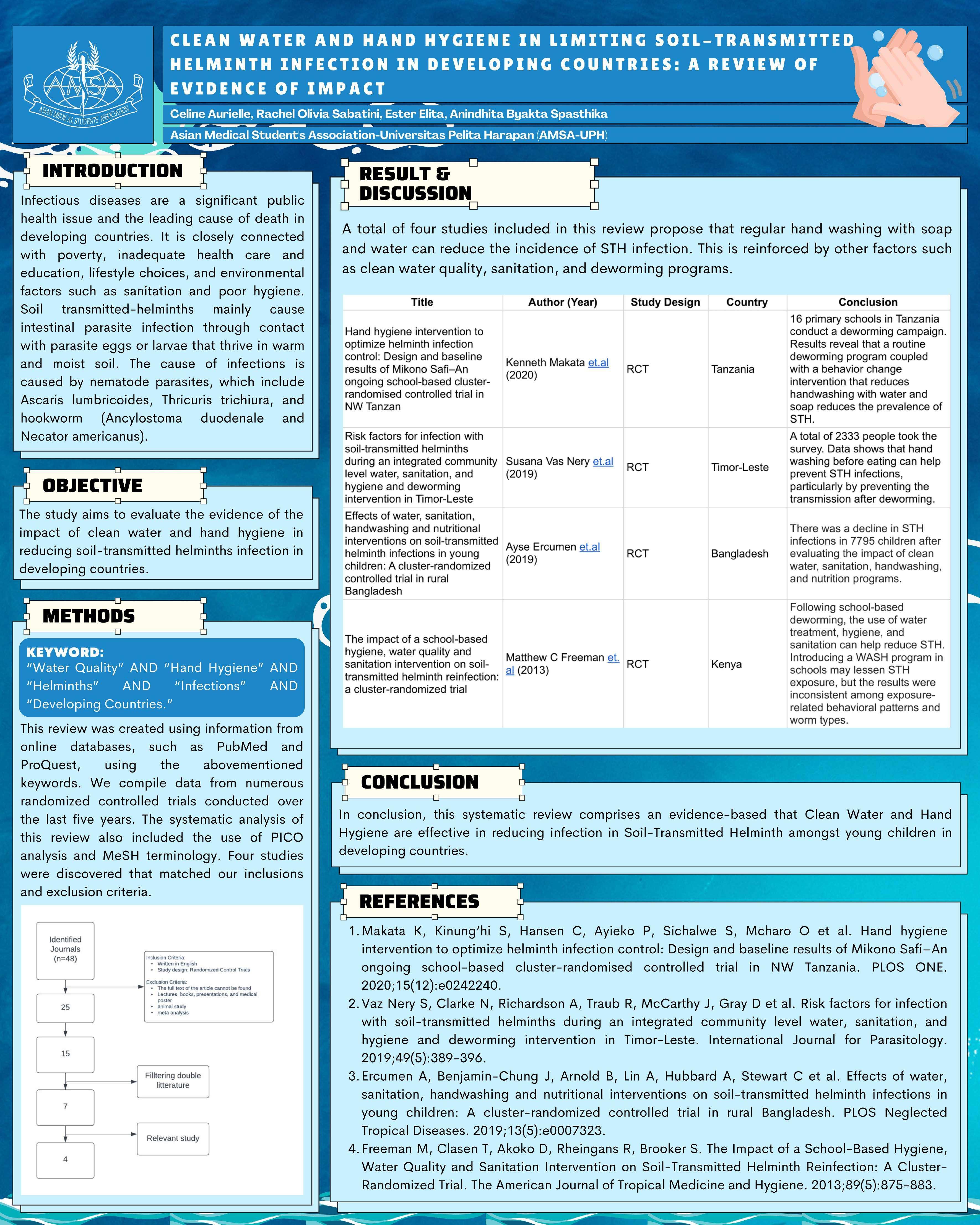
EFFICACY OF RTS,S/AS01 MALARIAVACCINE IN CHILDREN:
ASYSTEMATIC REVIEW
1
1Faculty of Medicine, Pelita Harapan University, Tangerang,Indonesia
1
Background : Malaria is a mosquito-borne disease accounting for 241 million cases in 2020 and has become a public health burden. Several methods have been employed in an attempt to control this disease with the most recent being vaccines. WHO has begun administration of RTS,S as the first generation malaria vaccine to children in endemic countries, such as Africa. This review aims to analyze efficacy of RTS,S/AS01 vaccine in children.
Methods : A systematic search was done to identify relevant literature from search engines PubMed, Google Scholar, and Science Direct using key words “RTS,S/AS01 malaria vaccine”, “Efficacy” and “Children”. Publications were limited to English Manuscripts published within the last 10 years. Inclusion criteria were RTS,S/AS01 malaria vaccine as intervention and children as study population. We excluded incomplete manuscripts, case reports, systematic review, and meta-analyses. A total of 8 studies were identified suitable for review.All studies were evaluated and scored using the JADAD scale.
Results : A total of 6 studies with 33,840 study participants were identified. Based on JADAD assessment, all 6 studies were of good quality All 6 studies showed that RTS,S/AS01 were protective against clinical malaria. Two studies showed that efficacy declined after 3-4 years.
Conclusions : This review found that the RTS,S/AS01 malaria vaccine had good efficacy among children. Further research and data collections are required in order to determine the need for booster and safety as preventive efforts for malaria, especially in endemic countries.
Keywords : Efficacy, RTS,S/AS01 malaria vaccine, children
Chandni Kumar1, Clarissa JasmineAurelia
, Ida BagusRam Kalpika Putra Mayun

The Efficacy of Povidone-Iodine (PVI) in Reducing The Rate of Infection in Wound Healing and Surgery Site Infection (SSI):ASystematic Review of Randomized Clinical Trial Yong Yee Wen
ABSTRACT
Introduction: Woundhealingisthecomplexbiologicalprocessofreplacingthedestroyedordamaged tissuebynewlyproducedtissue.Woundhealingcanfacechallengesandbeimpairedasaresultof infectionorheavybacterialburden.Povidone-Iodine(PVI)hasbeenusedasthepreventionofwound infectionforalongtimeduetoitsbactericidalabilityagainstalargearrayofpathogens.However,the efficacy of this agent in reducing the rate of infection have been debated.
Aim: TodeterminetheefficacyofPovidone-Iodineinpreventing infection,especiallyinwoundhealing and Surgery Site Infection.
Methods: LiteraturesearchwasconductedbasedonthePRISMAframeworkinPubMed,ScienceDirect, Publisher,andGoogleScholar,selectingRandomizedClinicalTrials(RCTs)systematicallyuptoOctober 15, 2022. Studies included discussed about patients who received Povidone-Iodine as
ResultsandDiscussion: Atotalof7randomizedclinicaltrialstudiesassessedtheefficacyof Povidone-Iodineinreducingtherateofinfections.In4out of7studies,wefoundthattheusageof Povidone-iodinewasprovedtohavegreaterriskofSurgerySiteInfectionandlesseffectiveinreducing the rate of infection.
Conclusion: Inconclusion,Povidone-Iodineisproventobelesseffectiveinreducingtherateofinfection inwoundhealingandSurgerySiteInfection.However,theusageofPovidone-Iodinecanbeconsidered because it is more convenient, safer, and more economical.
Keyword: Povidone-Iodine (PVI), rate of infection,wound healing, Surgery Site Infection (SSI)

SPRAIN YOURANKLE, NOW WHAT?
REALISTIC MAINTENANCE INAN OPTION ONLY IF IT CAN BE DONE SAFELY
Putri Khansha,AnnisaAdrianto, NafisaAdithya, Cyntha Nasyanda AMSA-Universitas Trisakti
Introduction: Reducepainandswelling,botharetheimmediategoalfortreatmentsofankle sprain,thismusculoskeletalinjuryisthemostcommonwithanestimatedincidencerateof 11,6% per 1000 exposures and a prevalence of 11,9%.
Hikinghasmanybenefits—itisgreatforourcardiovascularhealth,lowerbodystrength, proprioception,balance,andimprovingourmood.Theuneventerrainontrailsdoesposerisk forinjury,specifically,ananklesprain,whichoccurswhentheankleisforcefullyturned (“rolled inwardsoroutwards.Overtheyears,manyprotocolshavebeenusedtomanage acuteinjury,thethreemostrecentarePRICE(Protection,Rest,Ice,Compression,Elevation, POLICE(Protection,OptimalLoading,IceCompression,Elevation),andPEACEandLOVE (Protection,Elevation,Avoidanti-inflammatories,Compression,Education,Load,Optimism, Vascularization, Exercise).
Objectives: ToanalyseandcomparetheeffectivenessbetweenPRICE,POLICE,and PEACE and LOVE for ankle sprain therapy in wilderness.
Methods: DatawascollectedfromPubMed,ResearchGate,andGoogleScholarfrom 2012-2022, resulting in 3 studies for the review.
Results and Discussion: PRICE
Noeffectivenesswasfound,evenmuscleweaknessincluding bloodcirculationcannotflow perfectly, so gradually will cause tissue atrophy.
POLICE
Effectivebyreplacingrestwitharehabilitationprogrammetoimprovebloodflowandstimulate tissue healing.
PEACE and LOVE
Moreeffectiveitinducesbloodcirculation.Notincludinganti-inflammatorydrugshas become the standard of care for soft tissue injury.
Conclusion:
Whiletherearemanydifferentwaystorecoverfromasprainedankle,thereare3common methodstoeaseyoursprainedankleandthemosteffectivemethodisPEACEandLOVE.It’s importanttoknowwhichoneismosteffective.Themanagementshouldfocusonfavourable long-term outcomes, and treating the person not just the injury.
Keywords: sprain ankle, PRICE, POLICE, PEACE and LOVE,Wilderness Medicine

Effectiveness ofAcetazolamide Usage inAcute Mountain Sickness Prevention:A Systematic Review
Angely Maria Susanto, Josephus Regaldo Lake, Kezia Shanna Susanto [Correspondence E-mail: angely2j4@gmail.com]
Abstract
Introduction: Mountain climbers are vulnerable to mountain sickness, which can be dangerous or even fatal if ignored. It is caused by rapidly increasing altitude, which does not give the body enough time to adjust to decreased oxygen and changes in air pressure, resulting in hypobaric hypoxia. Acute mountain sickness (AMS) is brain pathophysiology manifestations. Acetazolamide was said effective to inhibit carbonic anhydrase by preventing its breakdown, this drug causes an accumulation of carbonic acid.
Objective: Our objective in this study is to evaluate the effectiveness of acetazolamide in mountaineers with altitude sickness.
Material and Methods: In our systematic review, we collected data from online resources which included, PubMED, NCBI, ScienceDirect, SpringerLink, Scopis, ResearchGate, and Google Scholar PICO analysis and MeSH terminology were used in the systemic analysis in this study.
Results: We analyzed seven different studies that elegible with 455 sample sizes. Four of our studies prove that acetazolamide is effective to prevent Altitude Mountain Sickness (AMS), two for rapid ascent, two with the examination in 3500 to over 4500 altitude. The studies showed that acetazolamide had greater effectiveness compared to other medications like budesonide or ibuprofen. Three studies show insignificant and ineffective acetazolamide in AMS, HAPE, HACE prevention. Some of the studies conclude that several doses of acetazolamide will not give a significant effect inAMS.
Conclusion: In conclusion to our study, we found that the use of acetazolamide iseffective to preventacutemountainsickness in mountaineers.Furtherstudies with largersample sizes are needed to evaluate the advantages, disadvantages,and side effects of acetazolamide
Keywords: Acetazolamide, Mountaineers, Acute Mountain Sickness, Systematic Review
Effectiveness of Acetazolamide Usage in Acute Mountain Sickness Prevention: A Systematic Review
¹Universitas Pelita Harapan


Results
Mountain climbers are vulnerable to altitude sickness (also known as mountain sickness), which can be dangerous or even fatal if ignored. It is caused by rapidly increasing altitude, which does not give the body enough time to adjust to decreased oxygen and changes in air pressure, resulting in hypobaric hypoxia. Altitude illness is a group of syndromes caused by hypoxia. Acute mountain sickness (AMS) and high-altitude cerebral edema (HACE) are brain pathophysiology manifestations, whereas high-altitude pulmonary edema (HAPE) is lung pathophysiology manifestation. Acetazolamide inhibits carbonic anhydrase. That is, by preventing its breakdown, this drug causes an accumulation of carbonic acid. Given the increased carbonic acid, which has a reversible reaction into bicarbonate and a hydrogen ion, the result is lower blood pH (i.e., more acidic).
This study of systematic review is to evaluate the effectiveness of acetazolamide in mountaineers with altitude sickness.
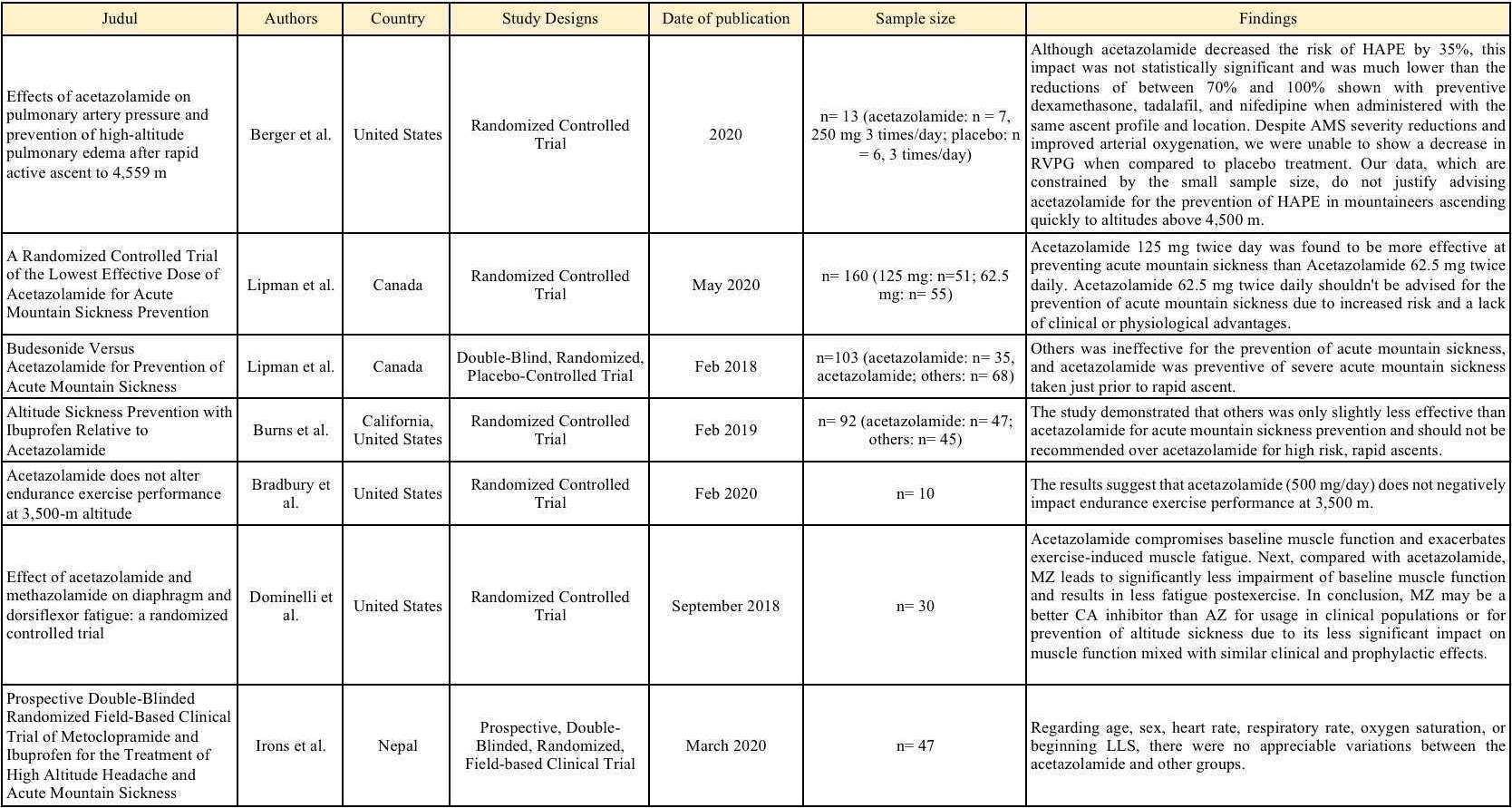

Discussion
We analyzed seven different studies that elegible with 455 sample sizes. Four of our studies prove that acetazolamide is effective to prevent Altitude Mountain Sickness (AMS), two for rapid ascent, two with the examination in 3500 to over 4500 altitude. The studies showed that acetazolamide had greater effectiveness compared to other medications like budesonide or ibuprofen. About 252 samples that suffer from Acute Mountain Sickness proved that the higher the altitude, acetazolamide can help the mountaineers. Three studies show insignificant and ineffective acetazolamide in AMS, HAPE, HACE prevention. Some of the studies conclude that several doses of acetazolamide will not give a significant effect in AMS.
KEYWORDS
Acetazolamide,

Introduction Objective Methods References
In conclusion to our study, we found that the use of acetazolamide is effective to prevent acute mountain sickness in mountaineers. Further studies with larger sample sizes are needed to evaluate the advantages, disadvantages, and side effects of acetazolamide.
Conclusion Recommendations
Further experimental analytic research in randomized controlled trials should be contacted to compare the effectiveness and understanding of acetazolamide usage in acute mountain sickness that contibute in mountaineers.
Conflict of Interest
ELIGIBILITY PubMed (n=16) NCBI (n=20) ScienceDirect (n=19) SpringerLink (n=33) Google Scholar (n=67) Records identified through databases searching (n=181) 1. 2. 3. 4. 5. Records after duplication removed (n=73) Records remained after screening by title and abstract (n=37) Full-text articles assessed for eligibility (n= 14) Studies included in qualitative synthesis (n= 7) IDENTIFICATION SCREENING INCLUDED Documents excluded on the basis of inclusion and exclusion (n= 23) Documents excluded on the basis of lack essential data (n= 7) Scan the barcode to see the references of our systematic review study. The researchers have no conflict of interest.
Angely Maria Susanto¹, Josephus Regaldo Lake¹, Kezia Shanna Susanto¹
EXCLUSIONINCLUSION Meta-analysis Literature Review Case-control study Systematic Review Case Remot Animal Study
Controlled Trial Retrospective Study
with
Randomized
Populations: Mountaineers
Mountain Sickness Intervention: Usage of Acetazolamide Comparison: Other Medications Outcome: Effectiveness of Acetazolamide in Acute Mountain Sickness
Mountaineers, Acute mountain sickness, Systematic Review
Antibacterial Peptides Inspired by Komodo Dragon's Blood asATherapeutic Potential for Drug Resistance in Pneumonia:ASystematic Review
Ignatia Kurniati, Insani Bintang Nusa, Naura Fadhilah, RahmiAulia Lesmana
Faculty of Medicine, Universitas Pembangunan Nasional Veteran Jakarta
ABSTRACT
Introduction: Indonesiaisatropicalcountrywithvariousspecies,includingbacteria. Bacteriasuchas P.aeruginosa, S.aureus,and Klebsiellapneumoniae cancausetropical infectiousdiseaseslikepneumonia.Resistancecanoccurintheuseofantibioticsasa treatmentforthisinfection.Therefore,thismakesthedemandforhigherpotentantibiotics. Komodoisknowntoendurenumerouspathogensintheirsalivaandrecoverfromawound inflictedonotherdragons.ItcanbeatherapeuticpotentialwiththehelpofCAMPs(Cationic Antimicrobial Peptides) in their blood.
Objective: Todiscoverthenewtherapeuticpotentialinovercomingresistantbacteriathat causedpneumoniabyanalyzingdatafromresearchonkomododragonbloodsamples,which are known to contain antimicrobial peptides.
MaterialsandMethods: AsystematicreviewwasconductedinEnglishlanguagearticles searchedfromSpringerLink,ScienceDirect,andPubMed.BooleanOperatorwasusedto makingkeywords.About33articleswerefoundandthenassessedaccordingtothePRISMA flow diagram, resulting in 3 articles evaluated and included here. Results: CAMPswerefoundinthekomododragon’sBloodintheformVKs(VK6,VK7, VK10,VK11,VK12,VK13,VK14,VK25).Then,syntheticpeptideswereinspiredbythe originalpeptides,DRGN-1,DRGN-6,DRGN-7,andDRGN-8.Thepeptidesweretestedby usinglowsaltphosphatebufferconditions(EC50)fortheirantimicrobialactivity,andalso testedbyethidiumbromide(EtBr)forbacterialmembranepermeabilization.Theresultshows thatthepeptideshaveantimicrobialactivityagainst P.aeruginosa, S.aureus, and Carbapenem-resistantKlebsiellapneumoniae andarepermeabletobacterialmembranes. DRGN-6showssignificantactivityagainstCarbapenem-resistantKlebsiellapneumoniae,as good as colistin.
Conclusion: Komododragon’santimicrobialpeptidesareapossiblealternativeto conventionalantibiotics.Forthehemolyticactivities,withfurthermodification,thepeptideis promising for future development.
Keywords: Komododragon,antimicrobialpeptide,drugresistance,pneumoniae,tropical disease
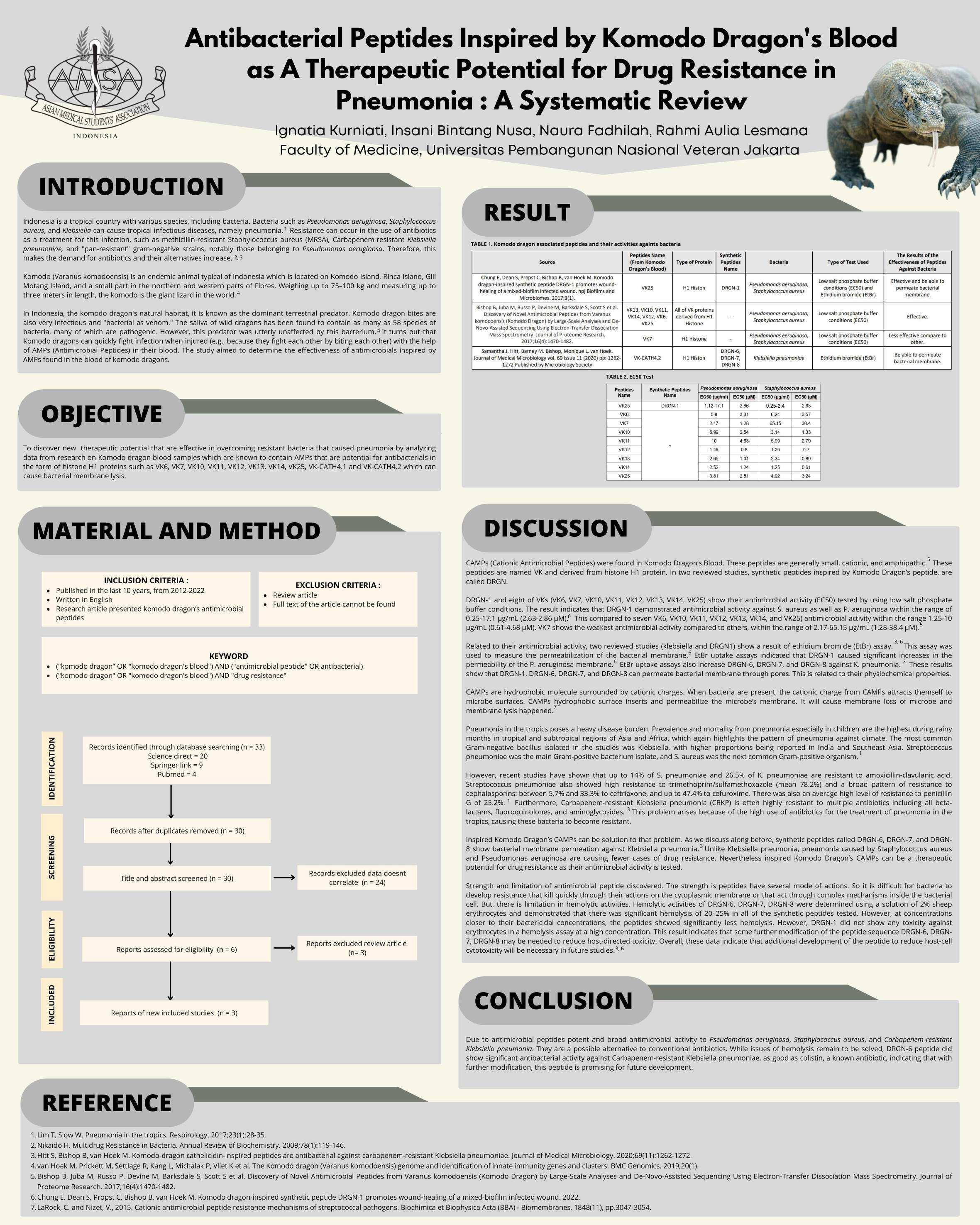
Salidroside Compound in Herbal Medicine Rhodiola as the Prevention ofAcute Mountain Sickness (AMS) :ASystematic Review
Introduction: Alongwiththeincreaseinaltitudewhenclimbingthemountain,thepartial pressureofoxygenalsodecreases,particularlyover2500m.Lowairpressurecanreducethe partialpressureofoxygen,makingitdifficultforoxygendiffusionintothepulmonary capillaries.Lowoxygenpressure(PaO2)inthearterialcirculationcanleadtohypoxic hypoxia. Ifthiscontinueswithoutcorrection,AcuteMountainSickness(AMS)canoccur.AMScan be preventedbyacclimatizationandprophylaxismedicine.Rhodiolahasbeenwidelyutilizedasa preventiveandcurativeintraditionalherbalmedicine.Rhodiolahasmanyactiveingredients, one ofwhichissalidroside(Sal).Salidrosideplaysasignificantroleinalleviatinghypoxia by inhibitingthebreakdownofHIF-1g,regulatingglycolyticmetabolism,reducingoxygen,and decreasing the anti-hypoxia effect.
Objective: TostudytheeffectsofSalidrosideinRhodiolaasapotentialmedicinetoprevent acute mountain sickness.
Methods: Weperformedasystematicsearchtogatherthedatafrom2017-2020inPubMed, ScienceDirect,andPLOSONE.UsingthePRISMAflowdiagram,wefoundsixexperimental studies that match with our inclusion and exclusion criteria.
Results: Weincludedsixexperimentalstudiesinrats(n=2)andcells(n=4).Wefoundthat SalidrosideinRhodiolacanincreasetheexpressionofHIF-1g,whichhasaneffectatthe cellular levelbydecreasingoxygenconsumptionandatthephysiologicallevelofthebody,canreduce the risk of pulmonary hypertension by lowering the mean pulmonary arterial pressure.
Conclusion: WeconcludethatRhodiolacontainingsalidrosidecanreduceoxygenconsumption in hypoxic conditions making it beneficial to prevent acute mountain sickness (AMS).
Keywords : Altitude sickness, hypoxia, salidroside,herbal
Theresia Leonita, FirdaAmalia, Enjeli Ulina, PuthemaAlfaridzky Hermawan
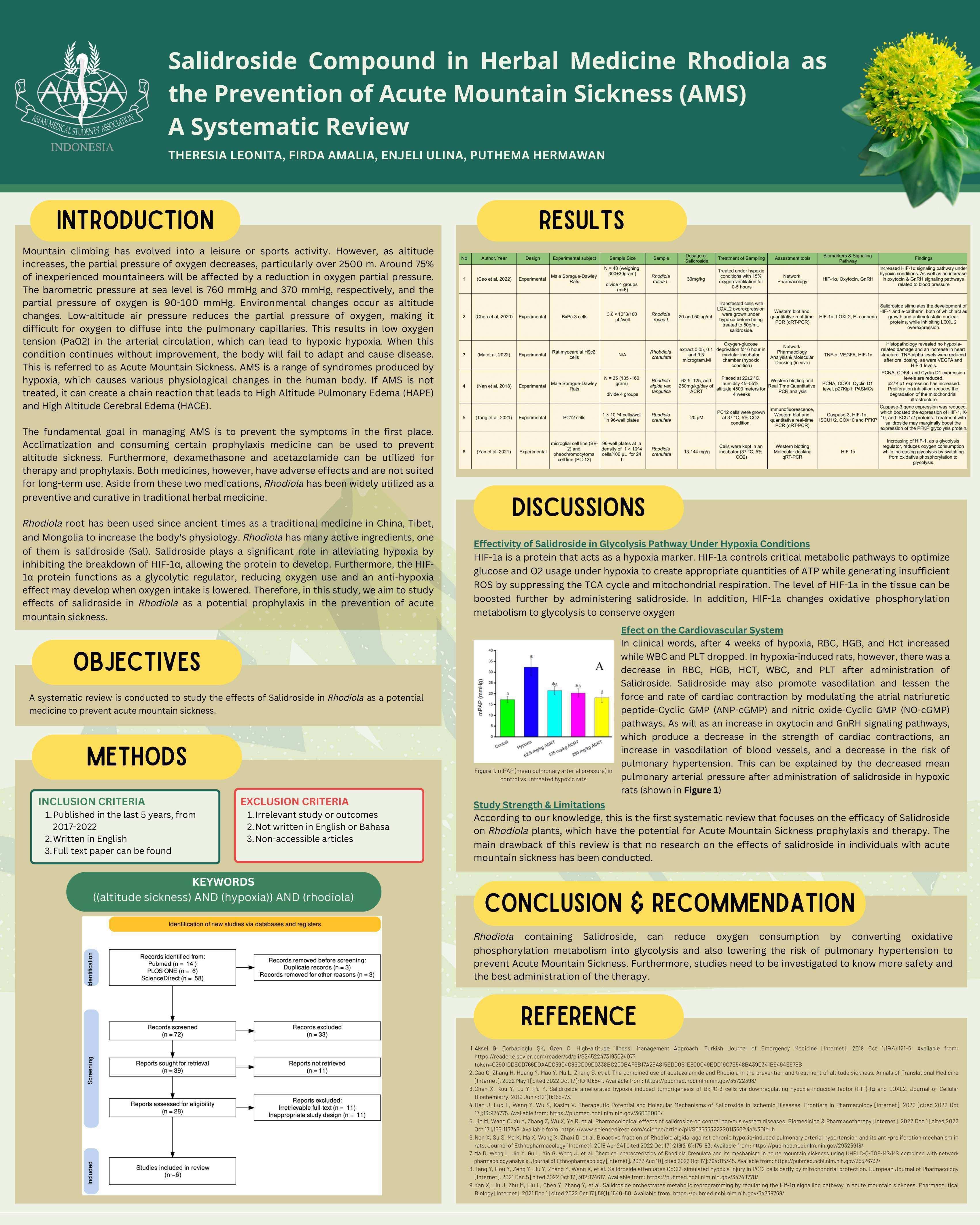
ヴ ゲキIニミWゲゲ デエ;デ ラミノ┞ エ;ヮヮWミWS キa キデげゲ
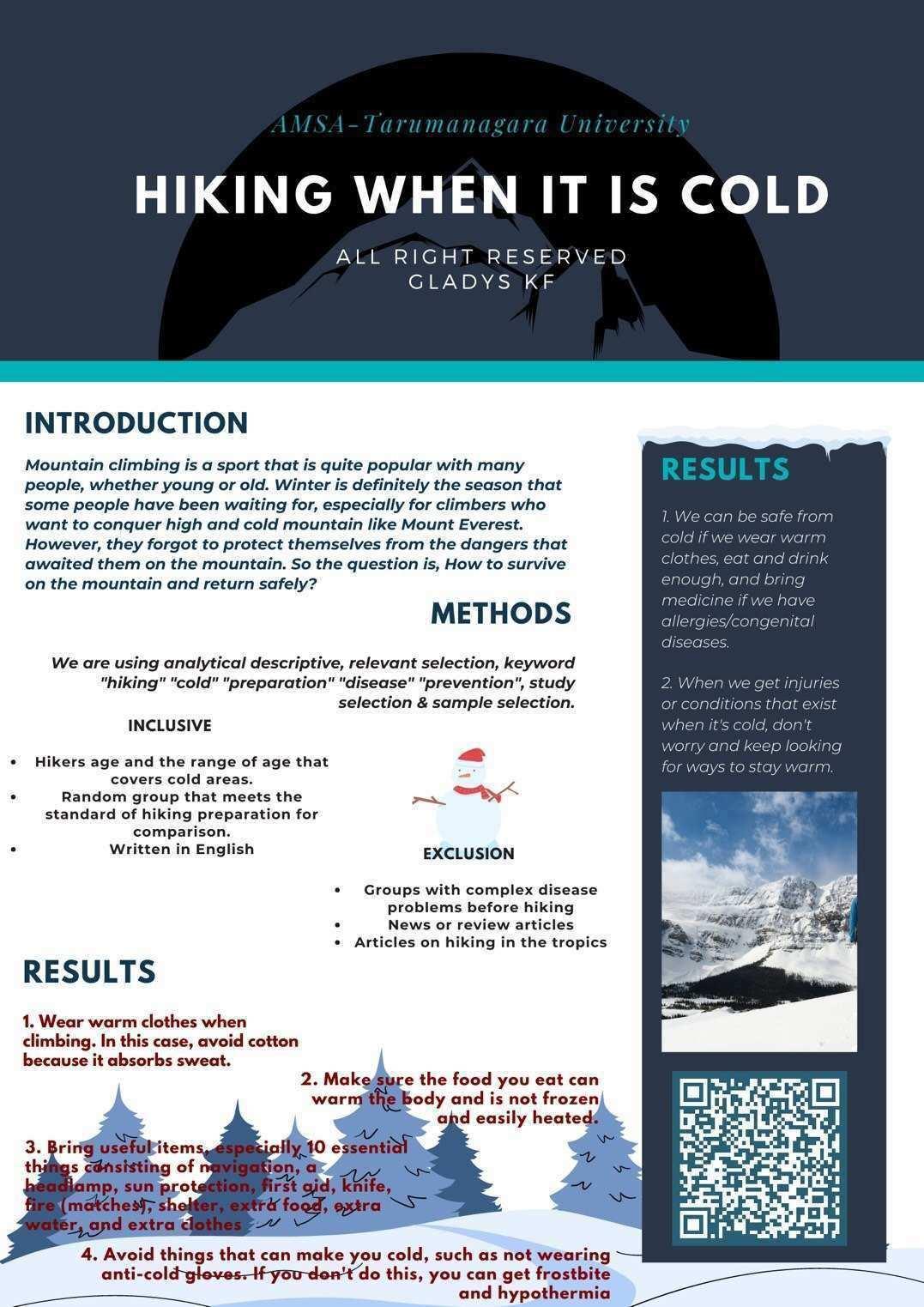
Comparison between Tafenoquine, Primaquine, and Chloroquine as Plasmodium Vivax Malaria Prophylaxis Treatment in Endemic Areas: A Systematic Review
Umar Agusta Wijaya, Emilia Angelica S.W, Vania Yuli Rahmantria, Attha Ghaly Ridho Ananda
AMSA-Universitas Jember
Introduction: Plasmodium vivax has the most widespread geographic distribution of the human malaria parasites, and nearly 2.5 billion people are at risk of infection. Trials using primaquine as a single drug for primary prophylaxis have been conducted. In endemic areas, it is also currently approved as a second-line chemoprophylactic drug for primary prophylaxis for transient residents who are not G6PD deficient. Primaquine is new alternative drug, tafenoquine, has a longer half-life and can be administered as a single dosage. In another hand, for about 70 years, chloroquine has been the recommended treatment for vivax malaria. However, in some endemic areas, we find that there is resistance for this drug.
Objective: To compare the antimalarial prophylaxis treatment against Plasmodium vivax malaria to guide recommendations for the optimal therapeutic strategy to use in clinical practice.
Methods: Literature search was conducted with multiple electronic databases, such as PubMed, Science Direct, Google Scholar, Cochrane Library, and SpringerLink from 20122022. According to the PRISMA flow diagram, resulting in 7 studies qualitative analysis. Risk of biases were assessed for each study using Cochrane Risk of Bias (RoB) 2.0.
Result: A total 7 studies assessed the treatment of Plasmodium vivax malaria in each endemic area. The main outcome showed that primaquine, chloroquine, and tafenoquine treatment has a positive and negative effect as the prophylaxis for vivax malaria. With the recommendation dose, chloroquine showed for its effectiveness at 300 mg dose approved by FDA.
Conclusion: Chloroquine still be the prophylaxis treatment for vivax malaria because its effectiveness for minimum causing any adverse effects.
Keyword: Plasmodium vivax malaria, Chloroquine, Primaquine, Tafenoquine, Endemic Areas
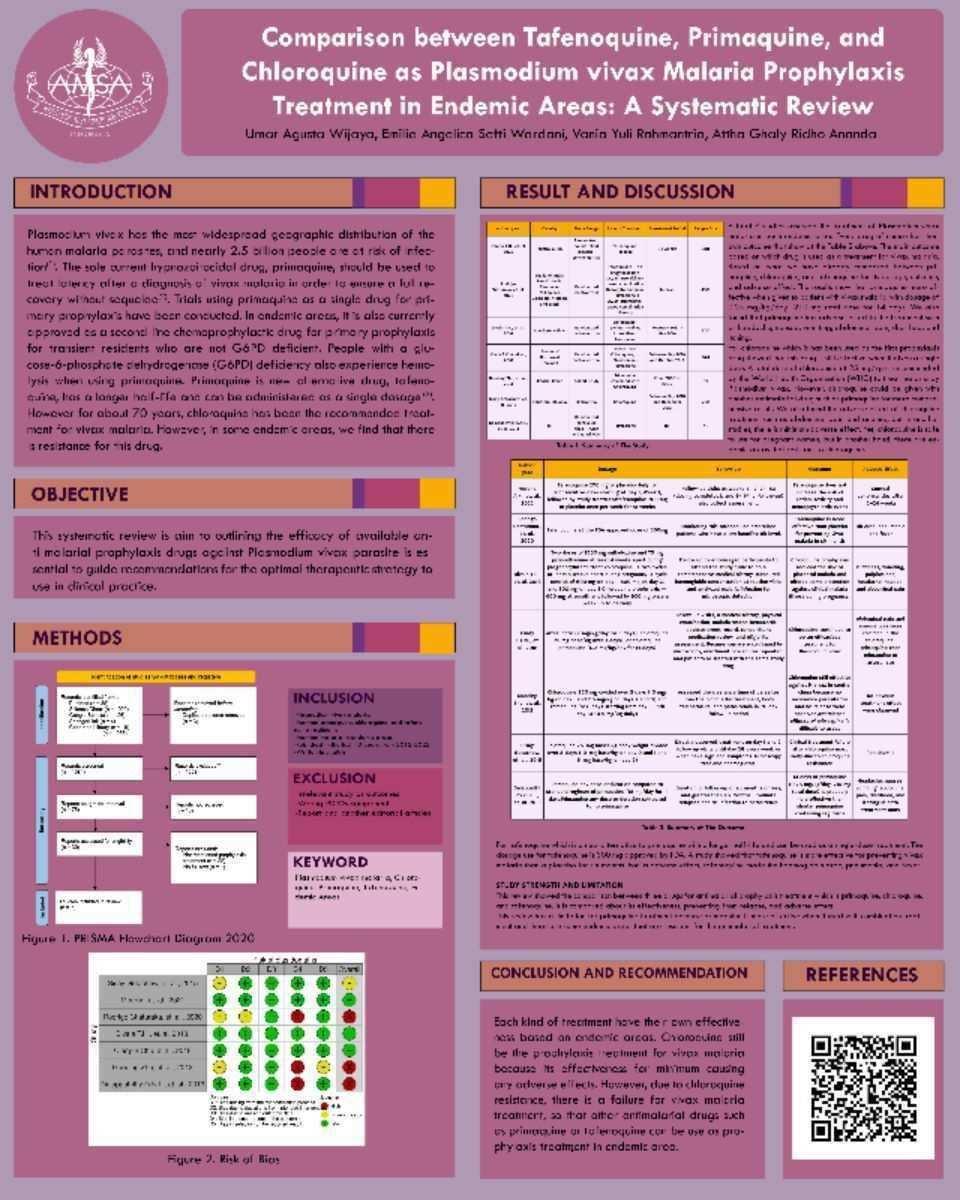
Efficacy of TAK-003 as The New Dengue Vaccine Candidate:ASystematic Review and Meta-Analysis
Anastasia MariaAngelica Montolalu, Derren David Christian Homenta Rampengan, Fralky Gabriel Marselino Maramis, Sinclair Jorlando Kakambong AMSA-Universitas Sam Ratulangi
Abstract
Introduction : Denguefeverisknownasthemostfrequentmosquito-borneviraldiseaseinthe world,withover390milliondenguevirusinfectionsestimatedtooccurannually.Dengueis causedbyfourvirusserotypes(DENV1–4),whicharetransmittedbymosquitovectors.. Thereremainsanunfulfilledneedforadenguevaccinethatcanbeadministeredwithout pre-vaccinationscreeningandisbeneficialregardlessofdengueserostatus.TAK-003isthe mostadvancedamongthedenguevaccinecandidatesunderdevelopment.Therefore,through thisstudy,wewantedtoexplorethepotentialofTAK-003asanewdenguevaccine candidate.
Objective :
ToinvestigatethepotentialefficacyofTAK-003utilizationasanewvaccinecandidatefor dengue.
Methods:
DatawerecollectedthroughPubMed,ScienceDirect,andResearchGatefromlastfive years studiesregardingtheefficacyofTAK-003asanewvaccinecandidatefordengue.A systematicreviewandmeta-analysiswasconducted,whichassesthedataextractedfrom resulting in 9 studies that were included; The risk of bias assessment graph.
Results:
TheadvantageofTAK-003whichisaLiveAttenuatedVaccineisthatitistheonlytype of denguevaccinethathaspassedphase3clinicaltrials.TAK-003containstheviralbackbone andthehighestvaccineefficacywasseenagainstDENV2,whichprovidesthegenetic backboneofTAK-003.ItwasreportedthattheefficacyofDENV2washigherthanothers, but positive results were still reported.
Conclusion: Overall, TAK-003 effective against dengue virus on all serotype
Keywords : TAK-003, Tetravalent, Dengue Vaccine

Analyzing Impact of AvalancheAsphyxiation In Correlation to Human Cardiac Physiology:ASystematic Review
Nalendra Pengayom Harsuno, Margaretha Amanda Tulung, Michael Janpri, Pandu Dhikanata Mangnga’ AMSA-Universitas Sam Ratulangi, Manado
ABSTRACT
Introduction: Avalancheisalargeamountoficeandsnowthatfallsquicklydowntothemountainslopeand causesdamage.Studiesregardingthistopichavebeenperformedandresultsshow75%ofthe fatalitiesarecausedbyasphyxia,25%arecausedbytraumaand1%causedbyhypothermia. Thosethatstruckinavalancheswereburiedbeneaththesnowarestillabletobreathdue tothe presenceofairpocketwhichregressassuffocationincrease,survivalrateofasphyxiais92% within15minutes,butonly30%at35minutes,intoonly3%at130minutesdependingonair pocketthatcontinuouslydecrease.Lackofoxygensupplyleadstodisruptionofcardiacfunction dependingonthedurationandhowobstructedtheairway.Forthatreasonasystematicreview was conducted to analyze the connection between avalanche, asphyxia, and cardiac function.
Objective:
Toanalyzetheactivityoftheheartinastateofoxygendeprivationduetoasphyxiacaused by avalanche-burial that may lead to suffocation.
Methods: ThissystematicreviewcollectsdatafromvariouselectronicdatabasessuchasPubMed, ScienceDirect,andClinicalKey,filteringoutpublicationswitharangeof>5yearsandonly usingfrom2017-2022. PreferredReportingItemsforSystematicReviewsandMeta-Analyses (PRISMA) was used as a guideline to select and rule out unrelated studies.
Results & Discussions: Wehaveanalyzedvariousstudiesthatdiscoveredthatcardiacfunctionandasphyxiaapparently connectedbytheamountofairoxygen,astheprolongedonsetofavalancheburialprompting hypoxiaorhypercapniaresultingincessationofcardiacmechanicalactivitythusmaking the circulation of blood in human body absent, this condition is called 'cardiac arrest'.
Conclusions:
Asphyxiationisthemostcommoncauseofdeathduringavalancheburial.Burialsnowthat consists of thick snow can cause cardiac arrest that will follow asphyxia and will threaten life.
Keyword: Avalanche, Asphyxiation, Asphyxia, Suffocation, Cardiac, Heart, Physiology
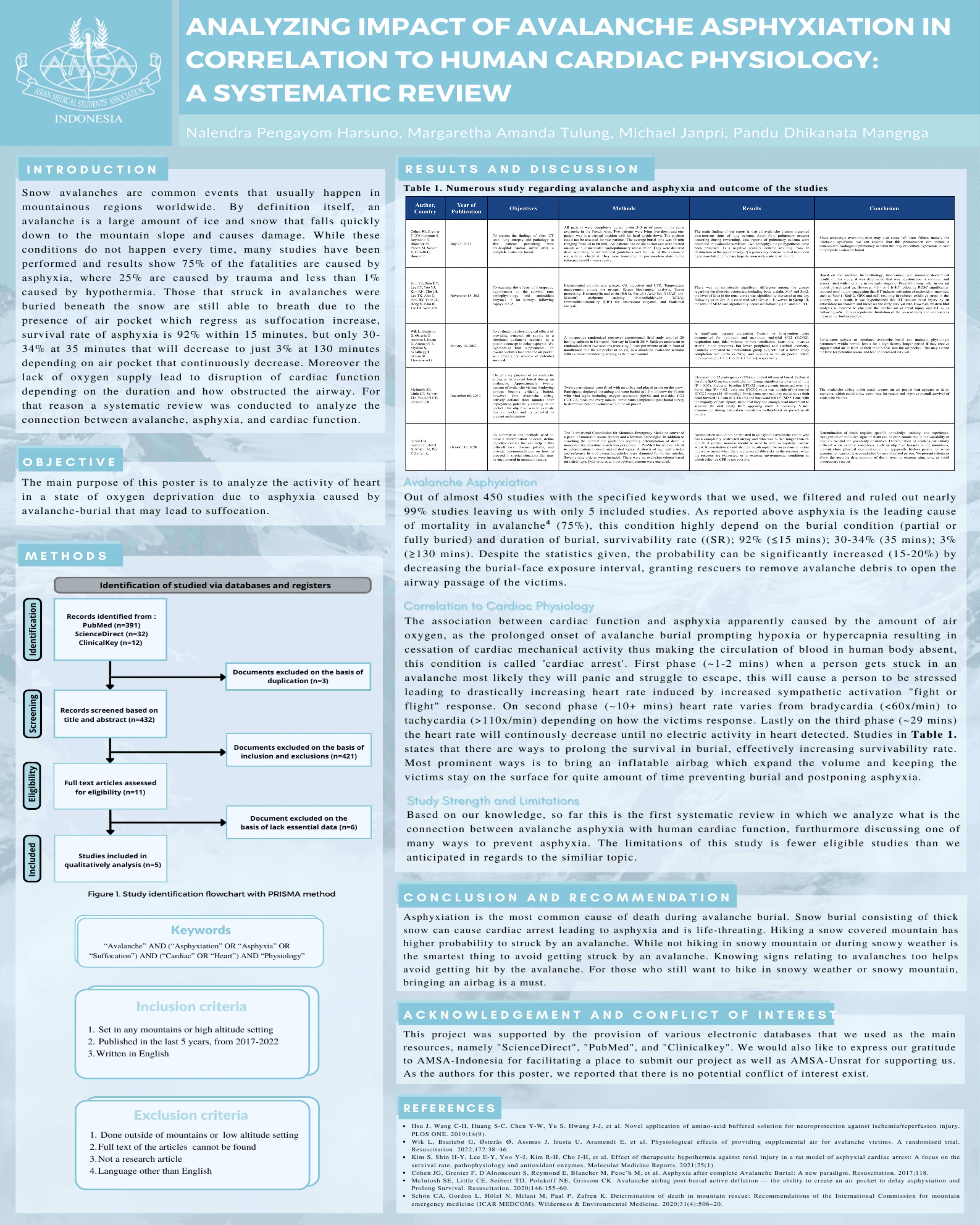
First Aids to Increase Core and Skin Temperature of Hypothermia Patients: A Systematic Review and Meta-Analysis of Prehospital Intervention
Natalie Gabriela Edravenia Tombokan1, Rifkanisa Nur Faiza2 , Shakira Amirah3 ,Josh Nathaniel Jowono3
1AMSA-Universitas Sam Ratulangi, 2AMSA-Universitas Gadjah Mada, 3AMSA-Universitas Indonesia
ABSTRACT
Introduction: Hypothermia is one of the most common health problems (96%) in mountain medicine that causes 1,500 deaths and 15,000 patients presented to hospitals every year. The prehospital phase is crucial to save lives. However, previous studies have only focused on perioperative interventions and there has been no systematic review and meta-analysis that focuses on prehospital first aid.
Objective: To investigate the efficacy of prehospital first aid for increasing core and skin temperature in hypothermic patients.
Method: A systematic review was performed based on the PRISMA guideline. The literature search was conducted in PubMed, Cochrane Library, Scopus, EBSCOHost, ProQuest, Wiley, SAGE, and Google Scholar. A meta-analysis was conducted using RStudio to compute the summary of mean difference (MD) and 95% confidence intervals (CI) for the core and skin temperature outcomes among different prehospital first aid interventions.
Results: Six randomized controlled trials (RCTs) with a total of 63 participants were included. The meta-mean of core and skin temperature shows a pooled MD of 0.36 (95% CI: 0.30−0.43) and 2.56 (95% CI: 2.36−2.78) respectively. The results indicate that those various prehospital interventions increased the core and skin temperature in hypothermic patients. Heterogeneity in terms of core (I2=0%) and skin temperature (I2=0%) was not found with P=0.74 and P=0.87 respectively, which means the differences between studies were not significant. Types of effective interventions on core and skin temperature are Warmcloud'-Warm cloud+Hotline®, chemical heatpad, ambulance blankets/quilts, charcoal heater, hot-water bags, single-layered polyethylene survival bag (plus hot drink), multilayered MPS survival bag (plus 4 large chemical heatpads), wet clothing removed or vapor barrier plus 1 woolen blanket, 2 woolen blankets, and Hibler's method.
Conclusion: Effective prehospital first aid is essential in saving hypothermia patients by extending the emergency time in the ‘golden hour’ period. However, further RCTs are required to assess prehospital intervention for hypothermia
Keyword: core temperature, first aid, hypothermia, prehospital, skin temperature
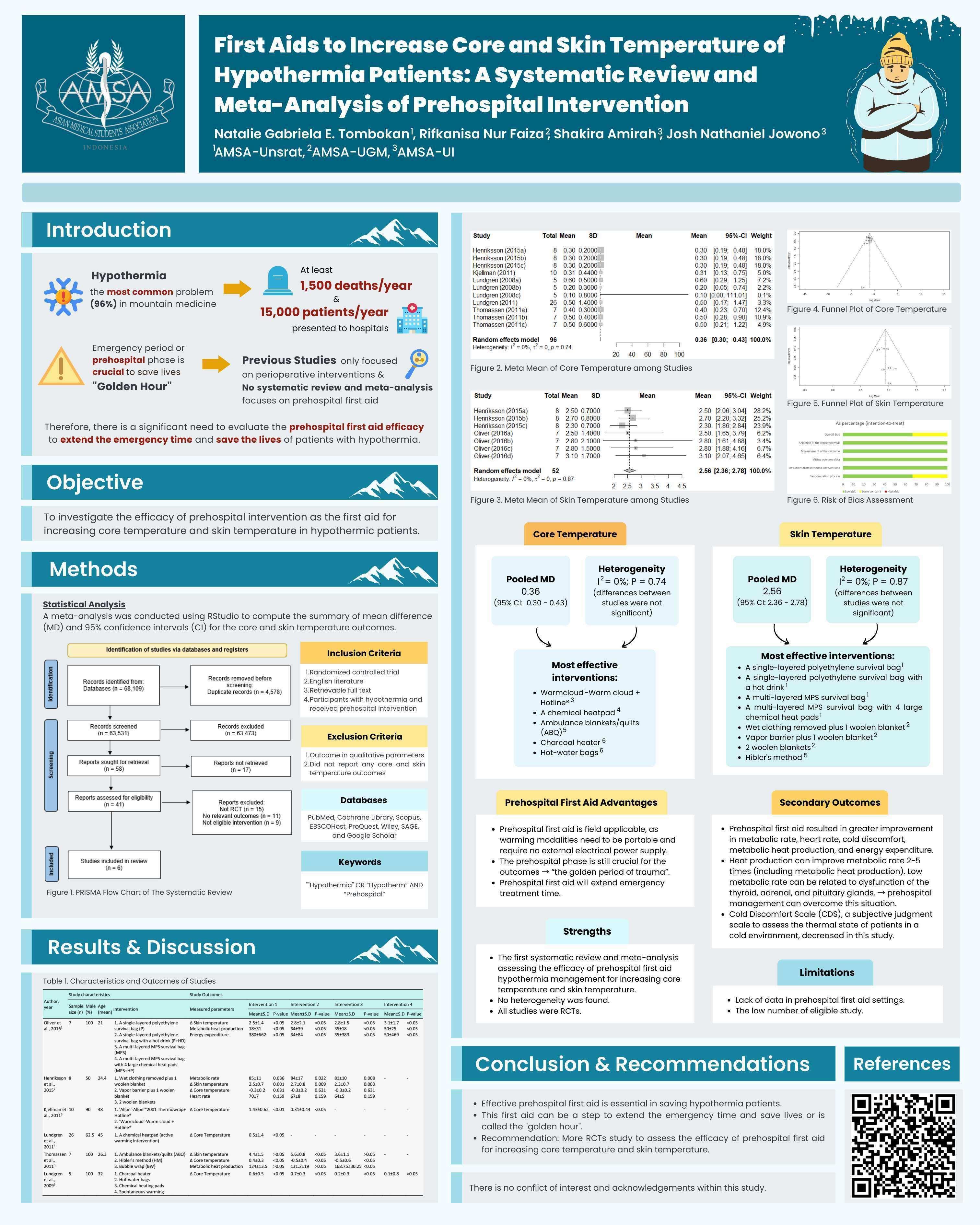
Efficacy ofAcetazolamide Intervention as Prophylaxis forAcute Mountain Sickness:A Systematic Review of Randomized Clinical Trials
Tesalonika Kyvenia Wilar, Charissa Melody Pali, Stefanus Vicky Bernhard Elisa Runtunuwu, GeniaAbigail Manuela Paat AMSA-Universitas Sam Ratulangi tesalonikawilar011@student.unsrat.ac.id
ABSTRACT
Introduction : AcuteMountainSickness(AMS)isaneurologicaldisorderthatfrequentlyaffectsmountaineers athighaltitudesasaconsequenceofchronichypoxiaatlowoxygenpartialpressure.Inthelast fewyears,thenumberofclimbersatriskofdevelopingAMSstartedtoimprove,correlated with theincreasingpopularityofmountaineering.Acetazolamide(AZ)isthemostcommonlyused prophylaxisforhighaltitudeillness. Wehopethatthisreviewwillassistgovernmentandmedical healthworkersinprovidingtheappropriateinterventiontohelpmountaineerspreventAMSand lower incidences.
Objective : To analyze the efficacy of acetazolamide as a preventive measure for acute mountain sickness.
Method : ThissystematicreviewwascarriedoutbasedonthePRISMAguidelinefrommultipledatabases usingsetkeywords.WeperformedasystematicsearchinPubmed,ScienceDirect,and Cochrane forstudiesreportingtheusageofacetazolamideforthereductionofAMSincidence.Atotal of 572studieswerefoundandthenfilteredbasedontheinclusionandexclusioncriteria.Quality assessment for included studies was based on the Cochrane Risk of Bias tool.
Results : Atotalofsixstudieswerereviewed.Allmeasuredtheefficacyofacetazolamideinreducingthe incidenceofAMS.Twoofsixstudiescomparedtheeffectivenessofacetazolamidewithother drugs,whilethreeofsixcomparedacetazolamidetoitselfbutwithdifferentwaysof administeringthemedicinewithorwithouttheuseofplacebo.Allofthestudiessuggest that acetazolamide has evidence for reducingAMS incidence in participants.
Conclusion : Inconclusion,AcetazolamideshowsanotableeffectinreducingAMSincidence,thusbeinga veryrecommendedhighaltitudemedicineforAMSprophylaxis.Furtherstudiesareneededto assess the optimal time and procedure regarding the usage of this drug.
Keywords : Acetazolamide, Acute Mountain Sickness,High Altitude, Prevention
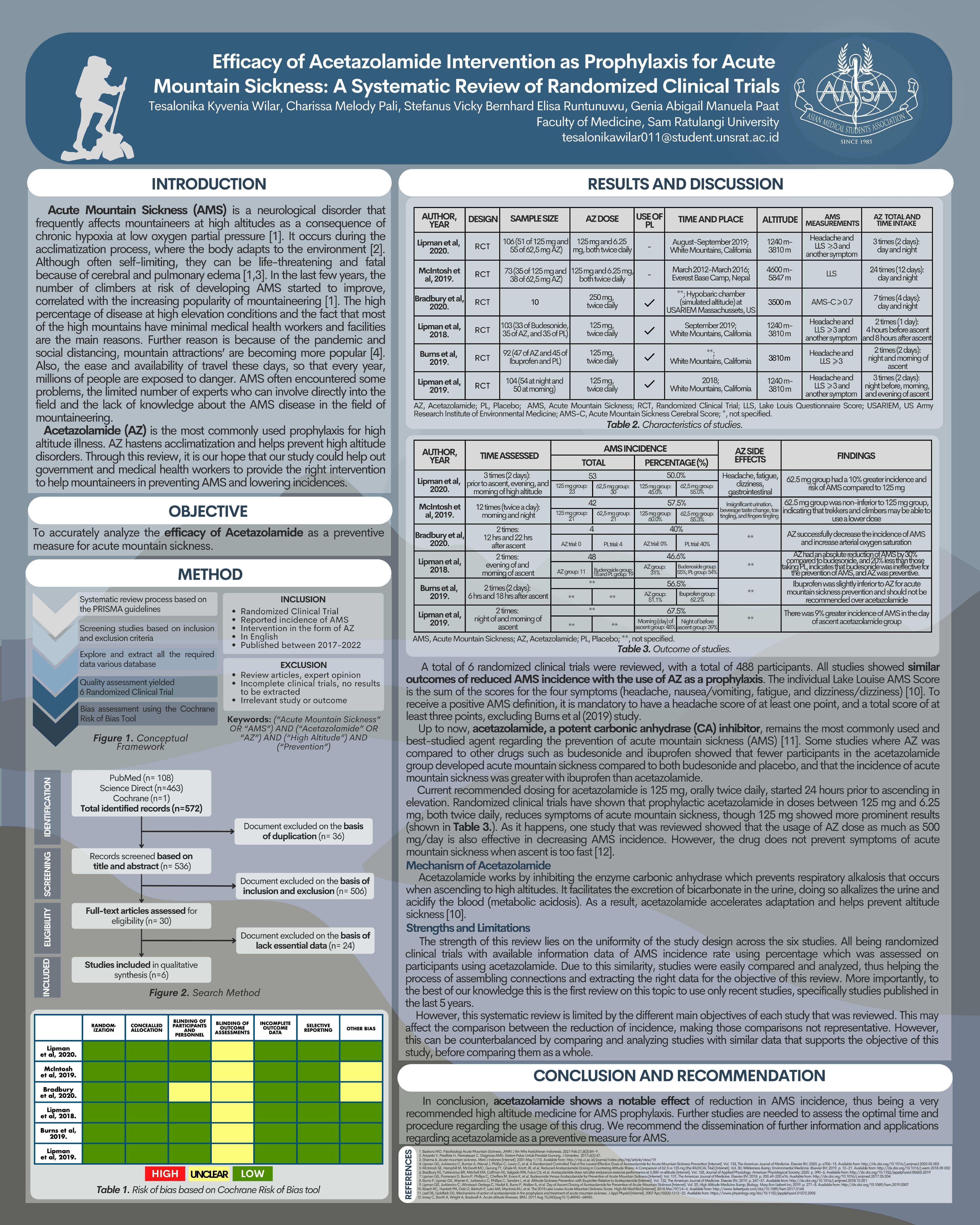
Comparing The Efficacy and Safety Triple-Drug Regimen with Double Drug Regimen for Lymphatic Filariasis in EndemicAreas:ASystematic Review of Randomized Controlled Trials
ABSTRACT
Introduction: Nowadays,LymphaticFilariasisisoneoftheendemicdiseasesinseveral areasdouble-drugregimen(DDR)treatmentforLymphaticFilariasisfacesmany disadvantagesforinstanceinneedsofmultipleroundsofadministrationandunabletolimit thetransmissionofmicrofilariainendemicdisease.Anewregimenhasbeenfoundcalledthe triple-drugregimen(TDR)anditshowsapromisingfuture.Therefore,wewanttoevaluate thesafetyandefficacyofTDRbycomparingitwithDDRespeciallyinendemic areas. Methods: DatawascollectedfromPubMed,Cochrane,ScienceDirect,andProQuestfrom 2018-2022.StudySelectionprocessbasedonPRISMAstatementandqualityassessmentwas conductedusingCochrane’sRiskofBiasToolinrandomisedtrials. Results: Threejournals reportclearanceofmicrofilariaobserved,TDRissuperiorcomparedtoDDR.However,three journalsthatreportedadverseevents,TDRhasahigherincidenceratecomparedtoDDR.In addition,accordingtotheonlyjournalthatreportedCFAclearance,DDRisalittlebitbetter thanTDR.Nevertheless,theadverseeventofTDRisstilltolerabletomostpeopleand similartoDDR. Conclusion: TDRinterpretsoutstandingdatacomparedtodoubledrug regimenintermsofefficacyandsafety.TDRisfasterinreducingmicrofilaria numberand circulatingfilariaantigeninthebodycausinglesstransmissionoffilaria.Inaddition,the adverseeventofaTDRissimilartoaDDR.Therefore,makingatriple-drugregimenis superiorandabetterchoicethanadouble-drugregimenfortreatinglymphaticfilariasisin endemic areas.
Keywords:lymphaticfilariasis,Ivermectin,Albendazole,Diethylcarbamazine,andEndemic Areas
Satria Rafi R., Yehezkial Gian P.P., Rifdania Putri D., TrianaAmelia Lasdianto
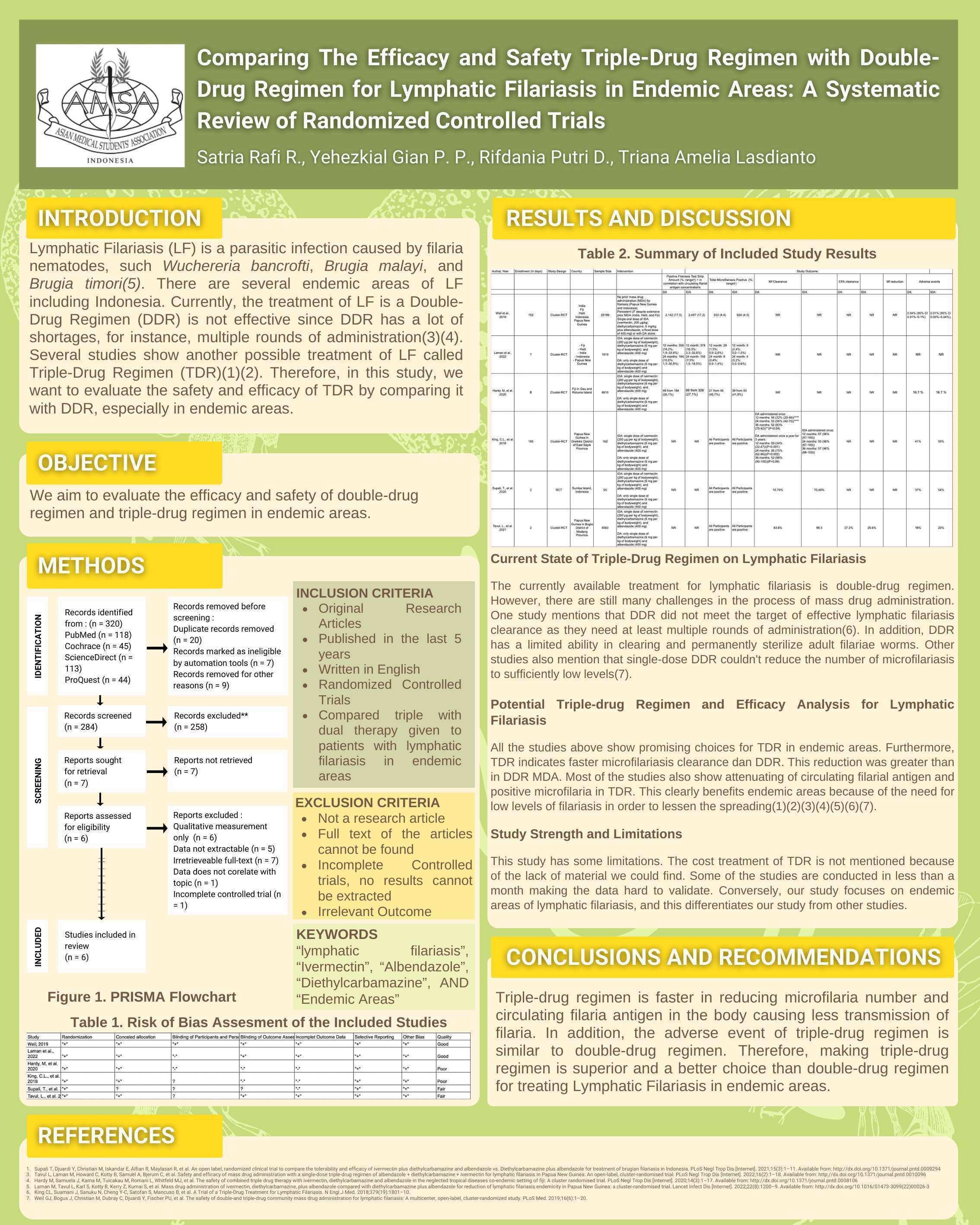
EFFICACY OF DEXAMETHASONE FORACUTE MOUNTAIN SICKNESSAND HIGHALTITUDE CEREBRALEDEMAPREVENTIONAND TREATMENT:A SYSTEMATIC REVIEW
Galena Devi, Syifa Rizkiaviani, Imanuely Denily, Muhammad Athar
ABSTRACT
Introduction: Theinterestofmanylocalandforeigntouristsinhikingthehighmountainsas anadventureisincreasing. High-altitudeCerebralEdema(HACE)isarare,life-threatening altitudesicknessandasevereformofacutemountainsickness(AMS). Dexamethasoneis effectivetoreduceAMSsymptoms.However,thereareonlyafewresearchstudies examiningdexamethasoneforthepreventionandtreatmentofAMS.Therefore,wewould liketoanalyzetheroleofdexamethasoneforAMSandHACEpreventionintheformofa systematic review.
Key findings: High Altitude Disease, Acute Mountain Sickness, Dexamethasone, Medication
Objectives: Toexplorehoweffectivedexamethasoneworksforpreventionandtreatmentof AMS and HACE
Materialandmethods: AsystematicreviewwasconductedinPubMed,Cochrane,and ScienceDirectdatabasebasedonPRISMAstatementandPICOguidelinestoidentify how dexamethasoneworksforpreventionofHighAltitudeDiseasesuchasAMSandHACE.We found 5 references that match our inclusion and exclusion criteria.
Results and Discussion: From 4 studies, all of themshowed using dexamethasone is effective forAMS and HACE patients. 2 studies comparing dexamethasone to placebo showed the results dexamethasone could reduce the incidence ofAMS with the ratio of 6.03. 1 studies showed that dexamethasone dosage for COPD patients is not recommended considering the severe side effects that will occur. 1 studies compare dexamethasone with budesonide in which both showed effectiveness to preventAMS but budesonide caused fewer adverse reactions than dexamethasone.
Conclusion: Most of the studies showed dexamethasonecould be shown successful as a priority choice of drugs for prevention and treatmentAMS and HACE in some special cases such as the need for a fast descent, but there are still a few studies who raised the theme of this research. More research needs to be done on testing the use of dexamethasone for prevention and treatment ofAMS and HACE.
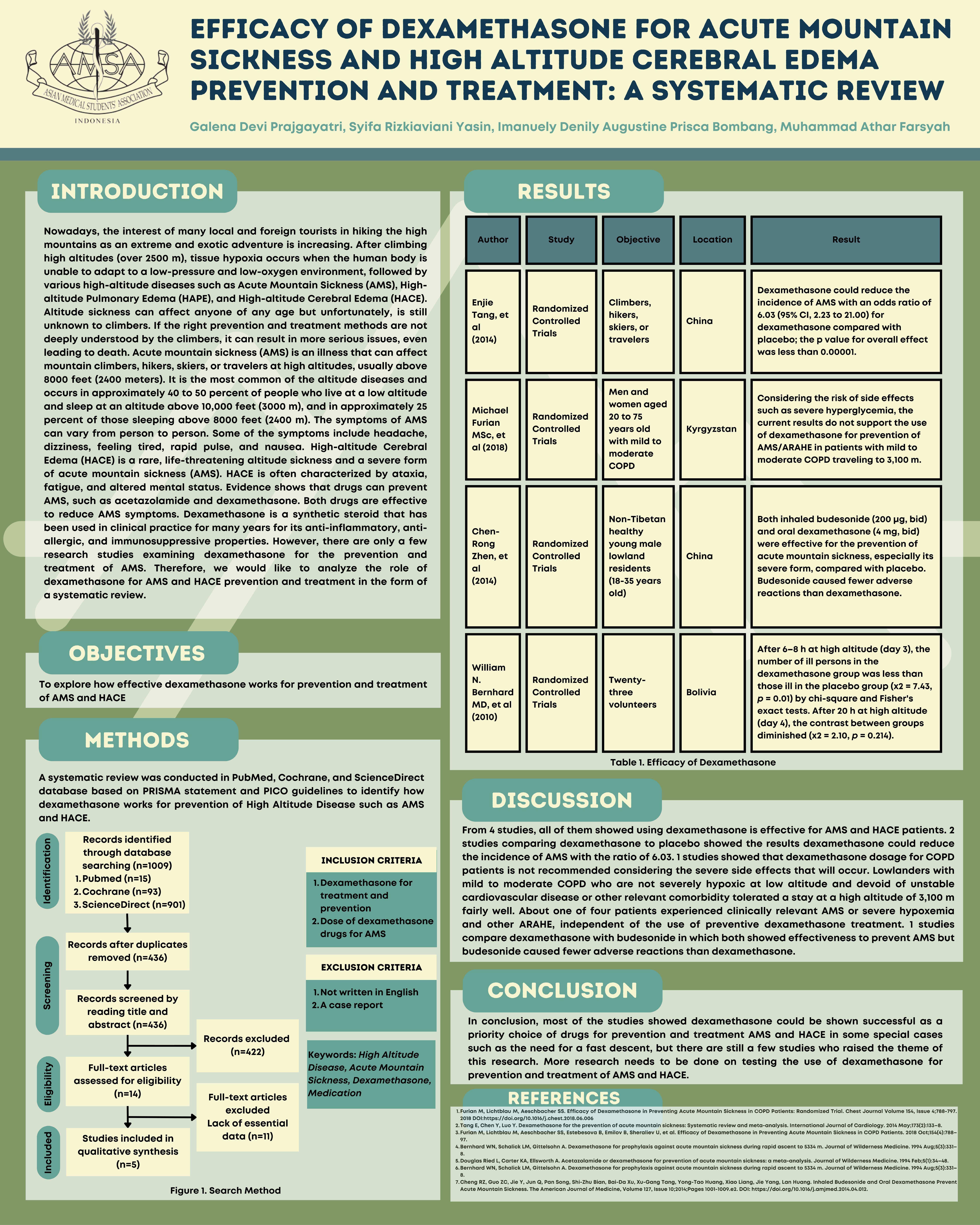




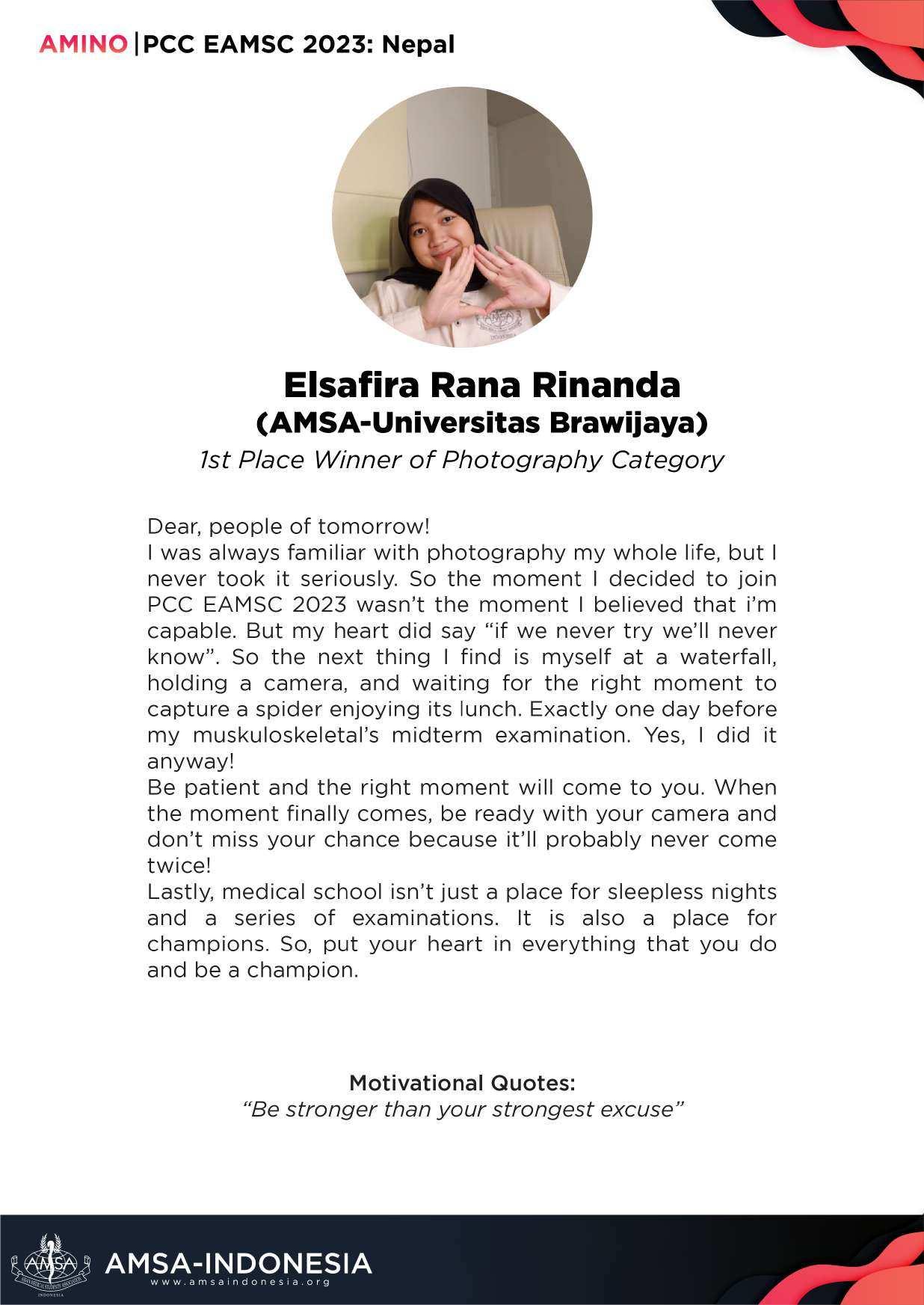
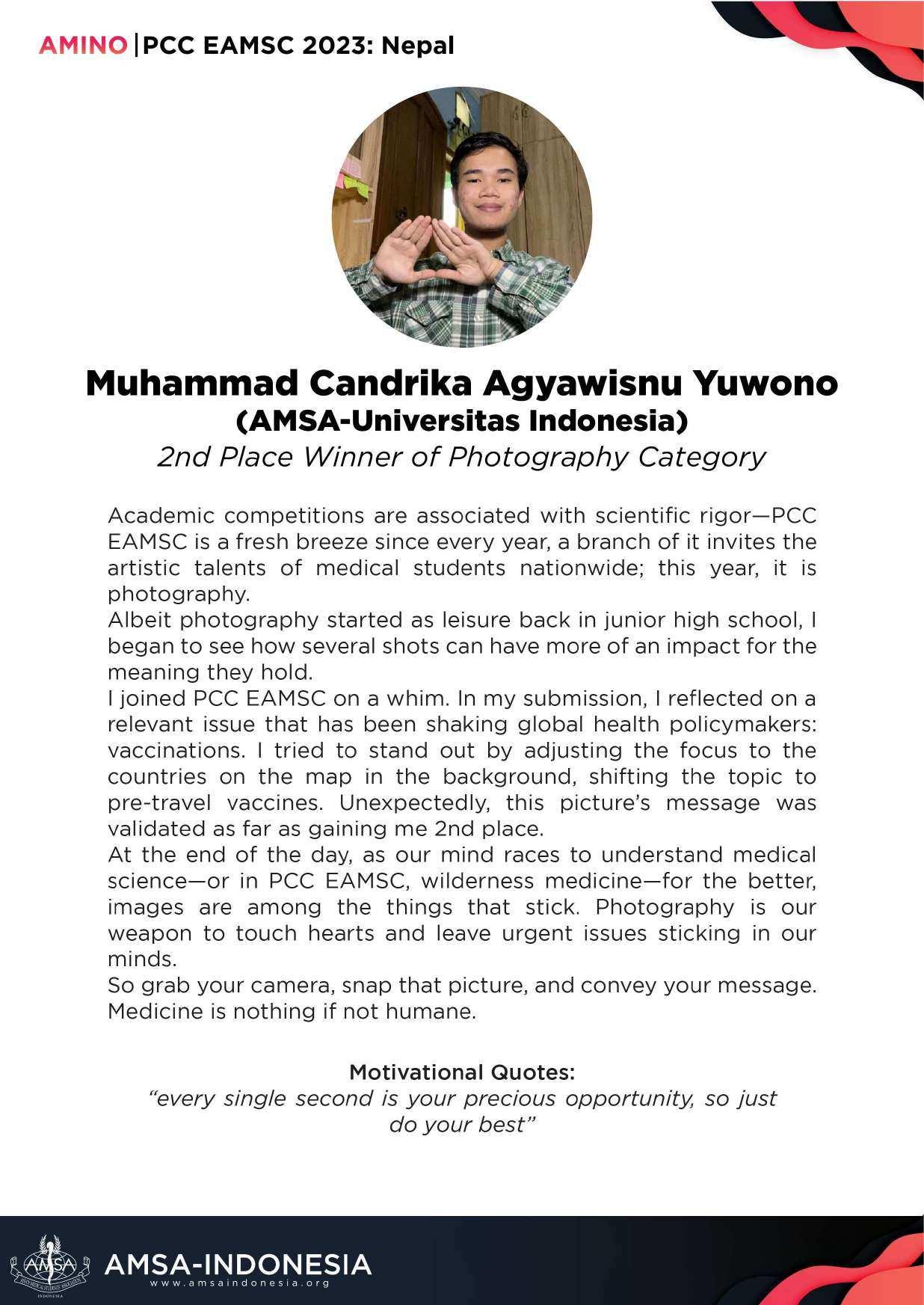
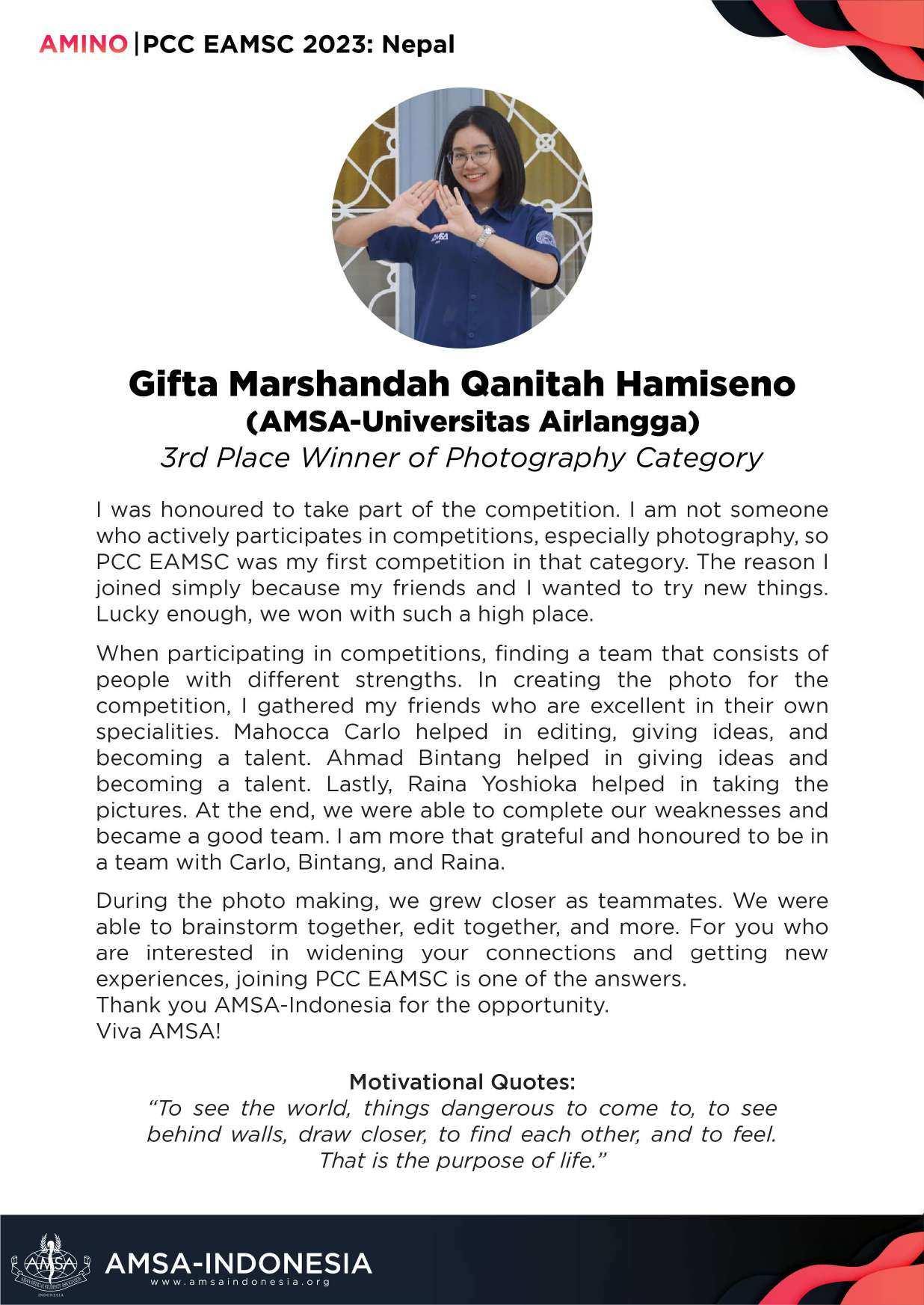
Bee Ware of Spiders!!!
Over 50,000 species of spiders have been identified in the world and more than 100 species are dangerous for humans. Spider bites are a common envenomation problem in the wild. Few of them are harmful, yet delay in treatment can cause death. Potentially being a threat to humans, spiders need to be taken seriously, especially in endemic areas.
Spider venom has 2 main characteristics; neurotoxic and necrotic. Neurotoxins could form ulcer and heavy destruction in the tissue and even paralysis of the nervous system. The venom damages the muscle system and blood cells which leads to breathing difficulties and ultimately death.
Stay calm!!! First step in handling spider bites: Carefully wash the bite area with soap and water. Apply a cloth dampened in cold water to reduce swelling. Elevate the bite area and Do not attempt to remove venom. Seek professional medical attention immediately!
This is why we need to “Bee Ware of Spiders!!!”
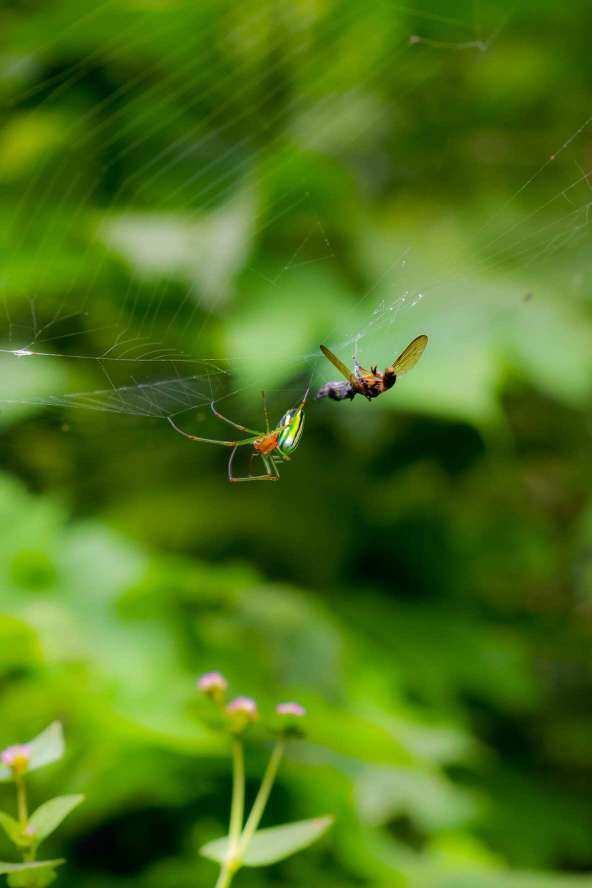
AMUST BEFORE YOU GO
Muhammad CandrikaAgyawisnu Yuwono [Correspondence E-mail: chikoyuwono@gmail.com]
Travel-relateddiseaseisoneofthemajorhealthchallengesintoday’smodernera.Everyyear millionsofpeoplevisitcountrieswithhygienicandepidemiologicalconditionsthataredifferent fromtheircountriesoforigin.1 Typhoidfever,hepatitis,meningitis,measles,andotherdiseases canposeathreatandhaveagreatriskofincreasingtravelermortalityrates.Therefore, immunizationisoneoftheimportantcomponentsrecommendedbyWHOinincreasinga person'sprotectionagainstinfectiousdiseasesespeciallywhentravelingabroad.2 However, unfortunately,severalstudiesshowthatvaccinationcoverageisstilllackingininternational travelpopulations.StudybySelcukatal.showsthat45percentofTurkishtravelerstoAfrica hadnottakenatleastoneoftherecommendedvaccines.3 Moreover,astudybyZhangetal reportedthattheoverallknowledgeaboutnationalandpre-travelvaccinationamongChinese travelersappearedsuboptimal.4 Severalfactorsthattriggertraveler'sreluctancetovaccinateare theperceptionthatvaccinationisuncomfortable,time-consuming,andexpensive.5 Hence,inthe future,itisnecessarytomakemoreeffortstoincreasepositiveknowledgeandattitudeinthe community towards pre-travel vaccination.
References
1.SteffenR,deBernardisC,BañosA.Travelepidemiology--aglobalperspective.IntJ AntimicrobAgents.2003Feb;21(2):89-95.doi:10.1016/s0924-8579(02)00293-5.PMID: 12615369.
2.WorldHealthOrganisation.Internationaltravelandhealth.Geneva:WorldHealth Organisation; 2018.
3.SelcukEB,KayabasU,BinbasiogluH,OtluB,BayindirY,BozdoganB,etal.Travel healthattitudesamongTurkishbusinesstravellerstoAfricancountries.TravelMedicine and Infectious Disease. 2016;14(6):614–20.
4.ZhangM,ZhangJ,HaoY,FanZX,LiL,LiY,etal.Vaccinationknowledge,attitudeand practiceamongChinesetravelerswhovisittravelclinicsinpreparationforInternational Travel. Journal of Travel Medicine. 2016;23(6).
5.WangJ,Liu-LastresB,RitchieBW,MillsDJ.Travellers'self-protectionsagainsthealth risks:Anapplicationofthefullprotectionmotivationtheory.AnnalsofTourism Research. 2019;78:102743.

Calamity in the Woods
Naturecanbeabeautifulplacetoexplore.Whetherit'sbyprobingthroughthewoodsor steppingonfreshgrass,theeagernesstowitnessnature'setherealityrepresentsthe desireto fulfill human curiosity; as a means of fathoming the secrets hidden within the world.
Natureconsistsofmorethanjusttreesandplants.Humanbehavior,infact,playsanimportant roleinthenaturalrhythm.Thedesiretocareforandhelponeanother,tonevertakeanythingfor granted, and to be aware of what is going on around them is a critical moment.
Whenamanwandersintothewoodsandfindshimselfindanger,itistheresponsibilityofthose aroundhimtohelphim.Helpingisneveraboutone'sabilitytohelp.Rather,itisalwaysabout the desire to care and the proclivity to empathize.
Furthermore,people'sdesiretolearnisneveradetrimentalthing.Theeagernesstolearnnew things,suchasCPR,splinting,andotherbasiclifesupportskills,cansavesomeone’slife.The more we learn, the more lives we will be able to save. Begin learning, and begin saving lives.

Anticipate, Prepare, and React

The wilderness of an environment may cause countless turns of events, especially things that can endanger or hurt people and even ourselves. However, most of it is predictable and our task before committing is to be prepared and when something happens, it is time to act.
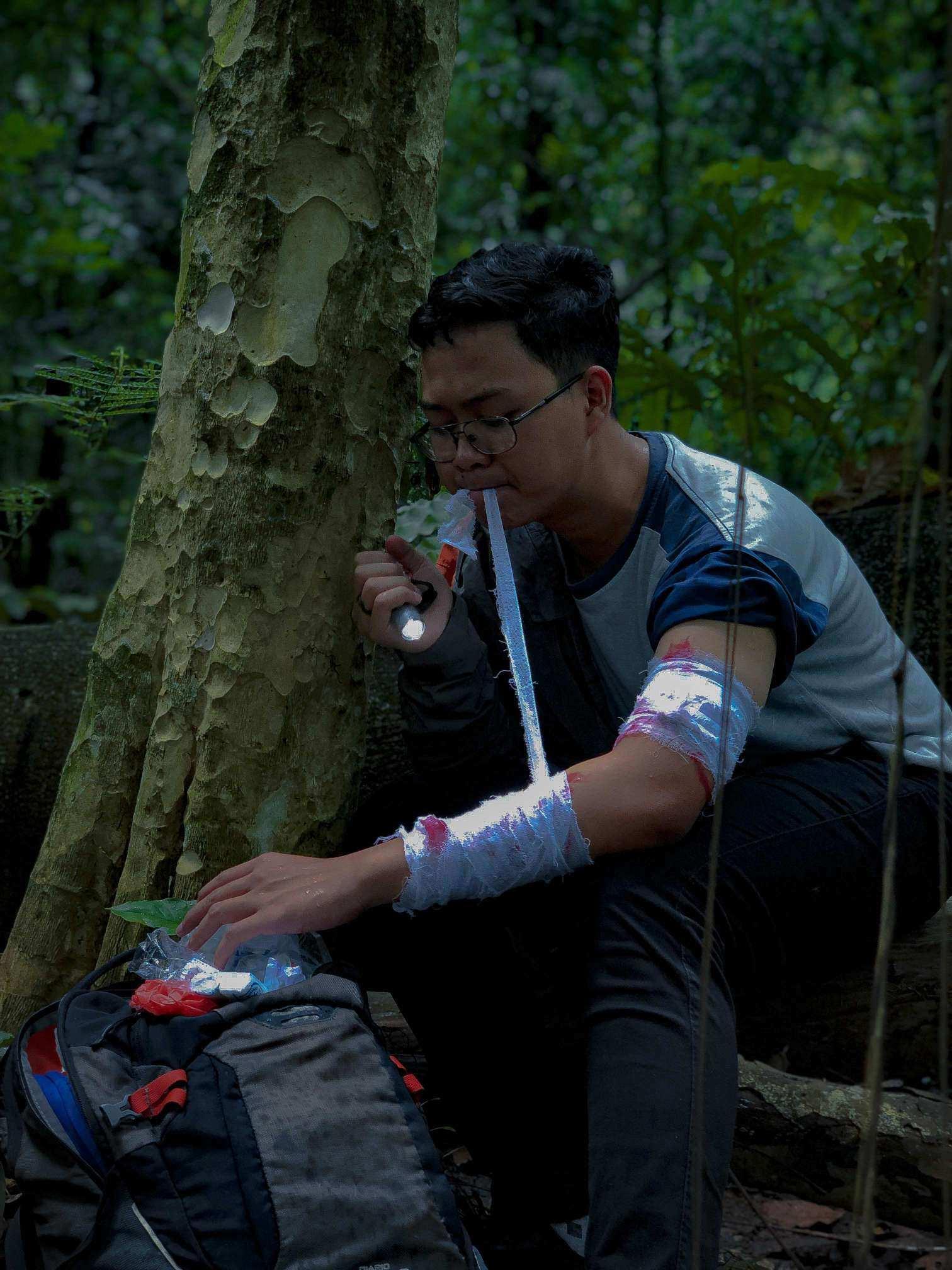
Venomous Creatures: Challenge for Us
Thisphotoportrayedagirlwhosehandisbeingexaminedbyadoctor.Arrivingwitha panickedface,shesaid,“Ijustgotbittenbyascorpionnearmyhouse.WhatshouldIdonow, doc?Am I going to die?”
Beingaprofessionalhealthcareprovider,thedoctortriestocalmherwhiledoingfirstaidto thegirl.Afteraskingsomequestions,turnedoutthesaidinsectisactuallycalledas whip-scorpion,anarachnidspeciesintheorderPedipalpida.Itdoeslooksimilartothe scorpion,asitisshowninthepictureandit’sindeedavenomouscreaturetoo,butitsvenom canonlycauselocalirritation.Someofthesymptomsthatcanbeobservedincluderedness, swelling, as well as itching and mild burning.
Thiseventshowsthatit’sreallyimportantforus,healthcareproviders,tounderstandwell aboutvenomouscreaturesandhowtodealwithitifweencounterone.Notonlypedipalp, there’remanyvenomouscreaturesthatfreelyroamingaroundus,eachwithdifferentlevelsof severity.Regardlessofthat,publicawarenessaboutthistopicisstillconsiderablylow. Therefore, it becomes a new challenge to us, who should help to spread the knowledge.
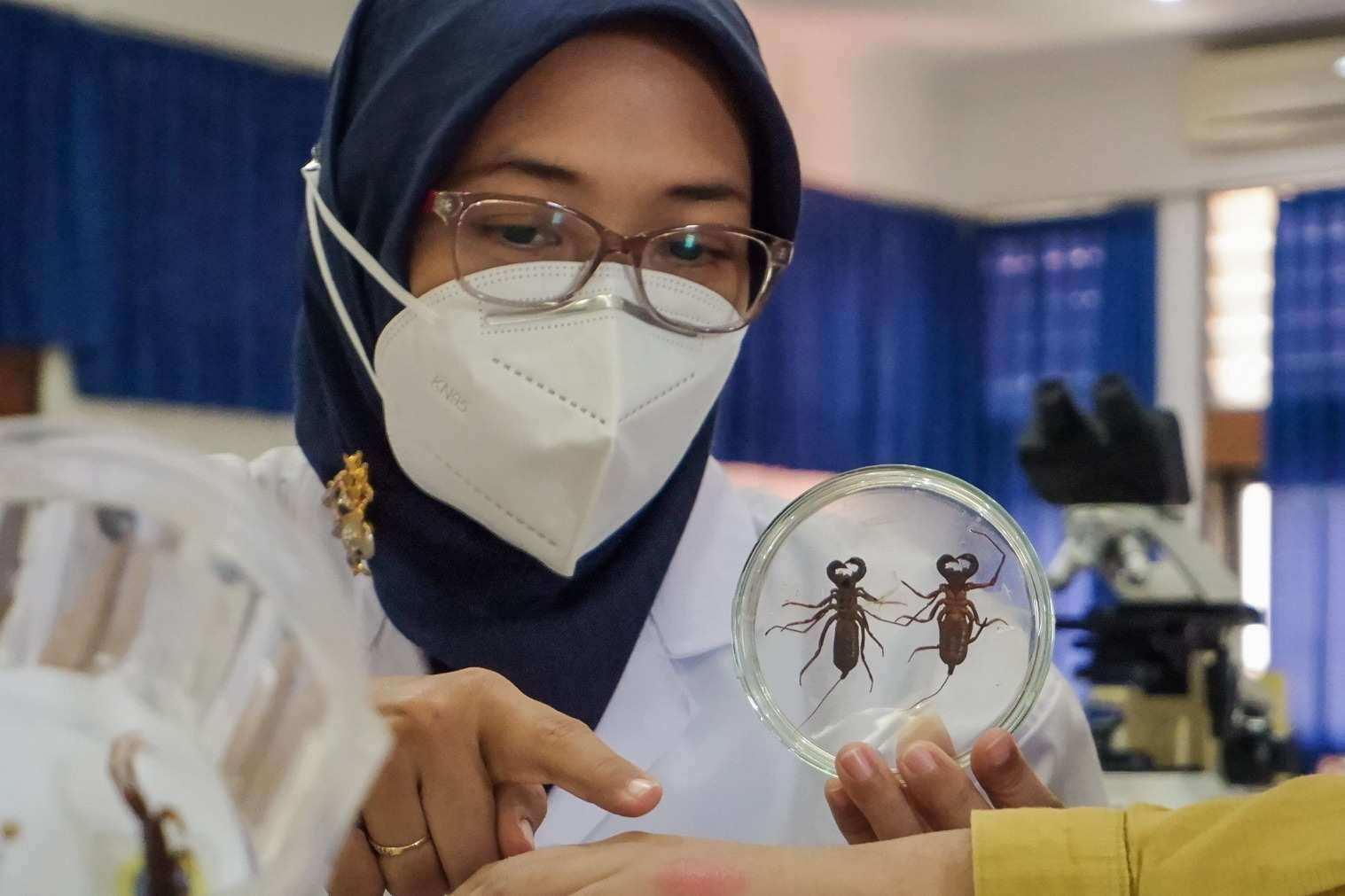
THE MOUNTAIN CLIMBERS PROTECTOR: BIVOUAC
A bivouac is a place used by climbers in the wild mountain to shelter from bad weather, wild animals, and other dangers. When hiking in the mountains, items around can be used to build into a bivouac or used in a suitable place as a bivouac such as a cave or a tree known as a natural bivouac. In addition, thereare artificial bivouacs made fromtools and natural materials and some are modern products such as nails, zinc roofs, and modified wood. Theadvancement of the bivouac manufacturing industry made it more practical to carry and use, known as modern bivouacs such as tents and flysheets. Several conditions need to be considered in the selection and manufacture of bivouacs, which are the place/location, time, manufacture material, and personnel count. A good bivouac is a safe, sturdy,and easy-to-usebivouac. Withouta goodbivouac, thesafetyand healthof climbers will be threatened and may increase the risk of accidents due to exposure to extreme temperatures and the threat of wild animals. However, no matter what the type of bivouac is, as long as it can be used for shelter, it will still be the protector for mountain climbers.
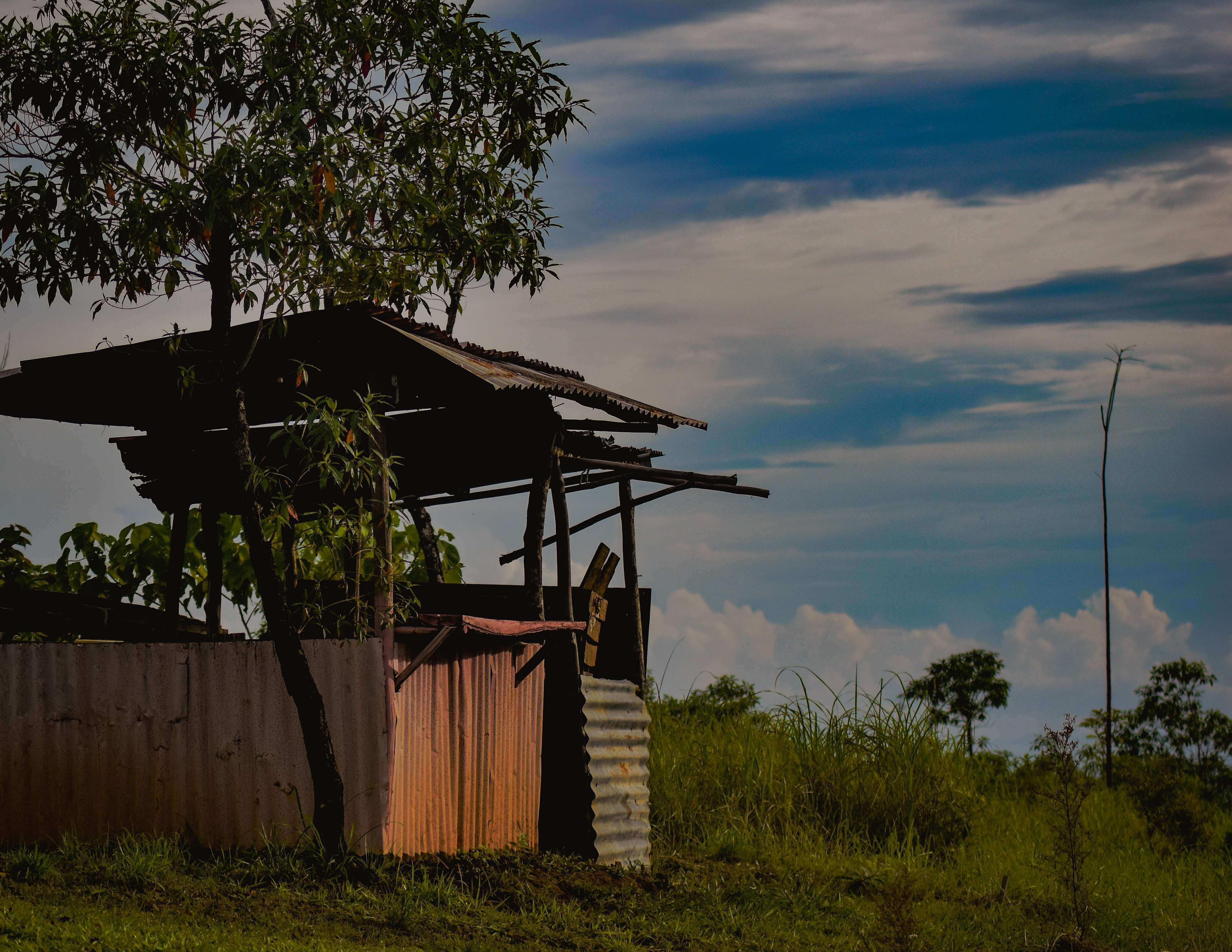
Hypothermia: Harmful Threat for Climbers
When you hear hypothermia, what comes to your mind? A few months ago, a climber was shocked by hypothermia while climbing Mount Lawu. Well, this incident certainly brings our attention that the condition of hypothermia needs responsive handling. What exactly is hypothermia?
So, Hypothermia is a condition when the body temperature drops below 35 o C. As a result, the heart and other vital organs fail to function. If not treated immediately, hypothermia can cause cardiac arrest, respiratory system disorders, and even death.
The condition of hypothermia is caused by being in a cold place for a long time, wearing clothes that are less thick in cold weather, and the absence of objects that can warm the body.
Symptoms of hypothermia are pallor, numbness, chills, decreased consciousness, weak breathing and pulse.
If while climbing we meet someone who has symptoms of hypothermia, the first action that must be taken is to check the pulse and breathing. Then take actions such as: cover the victim's body with a blanket or thick coat, and give warm and sweet drinks. Hypothermia can be prevented by wearing thick and warm clothes, and avoiding wearing wet clothes in cold weather.

New Hope After Sunset
Traveling is one way to normalize life patterns. some of them choose the mountain as a place of recreation. Moreover, mountain climbing has become a necessity in today's youth life. due to the lack of knowledge of novice climbers, many of them experience interference to the inevitable pain. the importance of knowledge about endurance in the mountains for every climber is very important. To avoid things that are not reasonable and can cause panic. It is important for us to inform the best conditions for climbing. Serious threats can occur to climbers in the wild. Due to the increasing trend of mountain climbing but not being matched by adequate educational supplies, a campaign is needed as a solution to increase the alertness of climbers. My last message is that we care and respond to High Altitude Pulmonary Edema & High Attitude Cerebral Edema to reduce casualties every year.
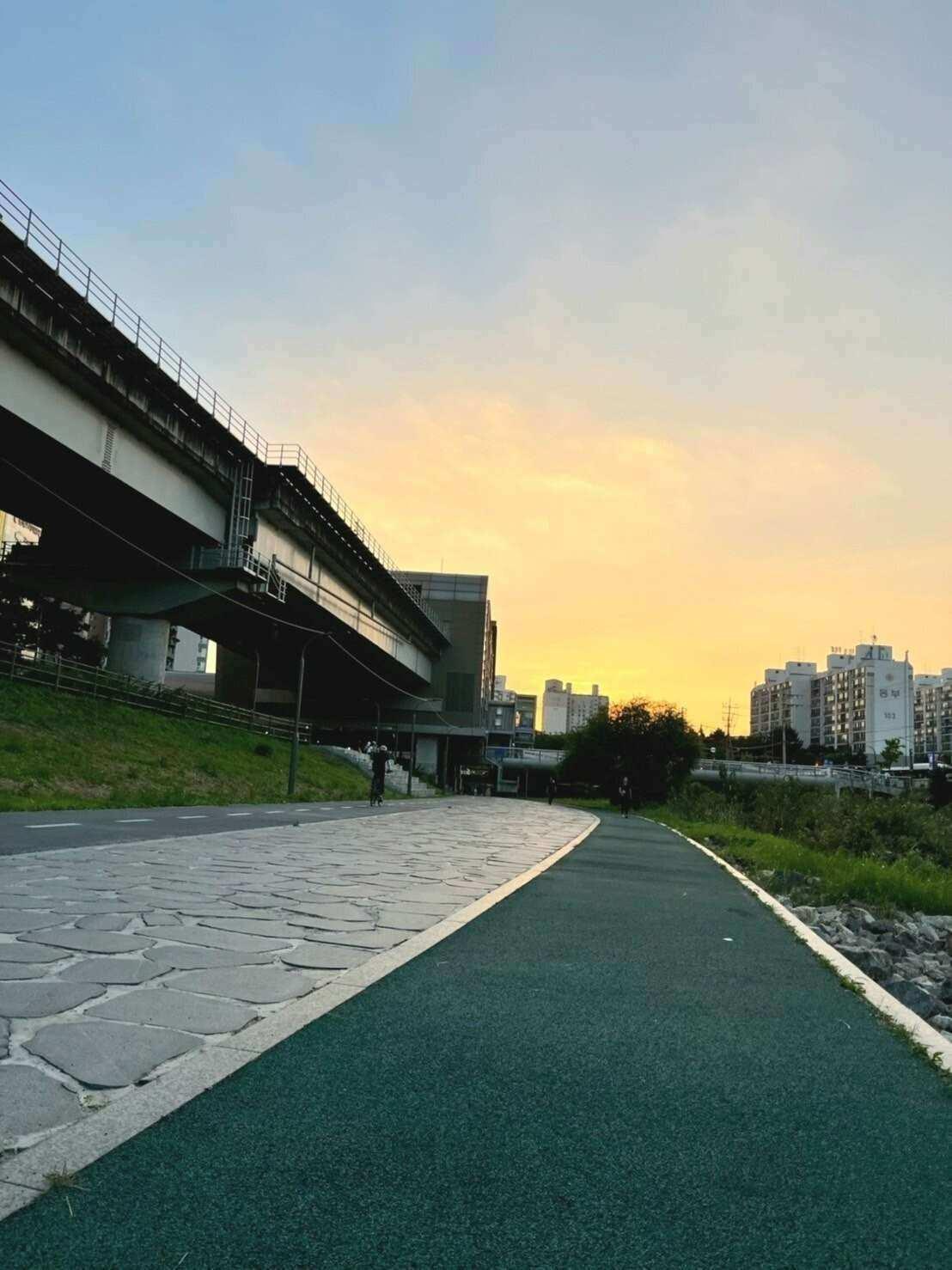
The Village Above the Clouds
Waerebo or known as the village above the clouds is a destination that is never wrong to choose. Having a beautiful panorama, rich in culture and ethnicity has become the identityof Waerebo. As a person who likes to travel long distances, tourists will visit there to find a new atmosphere. However, don't let things go wrong after a long trip. Waerebo has an altitudeof1,200 meters above sea level, requires physical health on the way. It's impossible for tourists not to preparethemselves because to get there you must do tracking for 2-3 hours, starting with physical health. Talking about altitude, people at high altitude for short periods of time, and who are not adapted to the environment, they are at risk for acute altitude sickness involving pulmonary and cerebral edema, and after extended periods of time at high altitude, for chronic altitude sickness involving pulmonary hypertension and related complications. So howabout the people who areliving at high altitudes? Our body has a mechanism called acclimatization, During acclimatization over a few days to weeks, the body produces more red blood cells to counteract the lower oxygen saturation in blood in high altitudes.
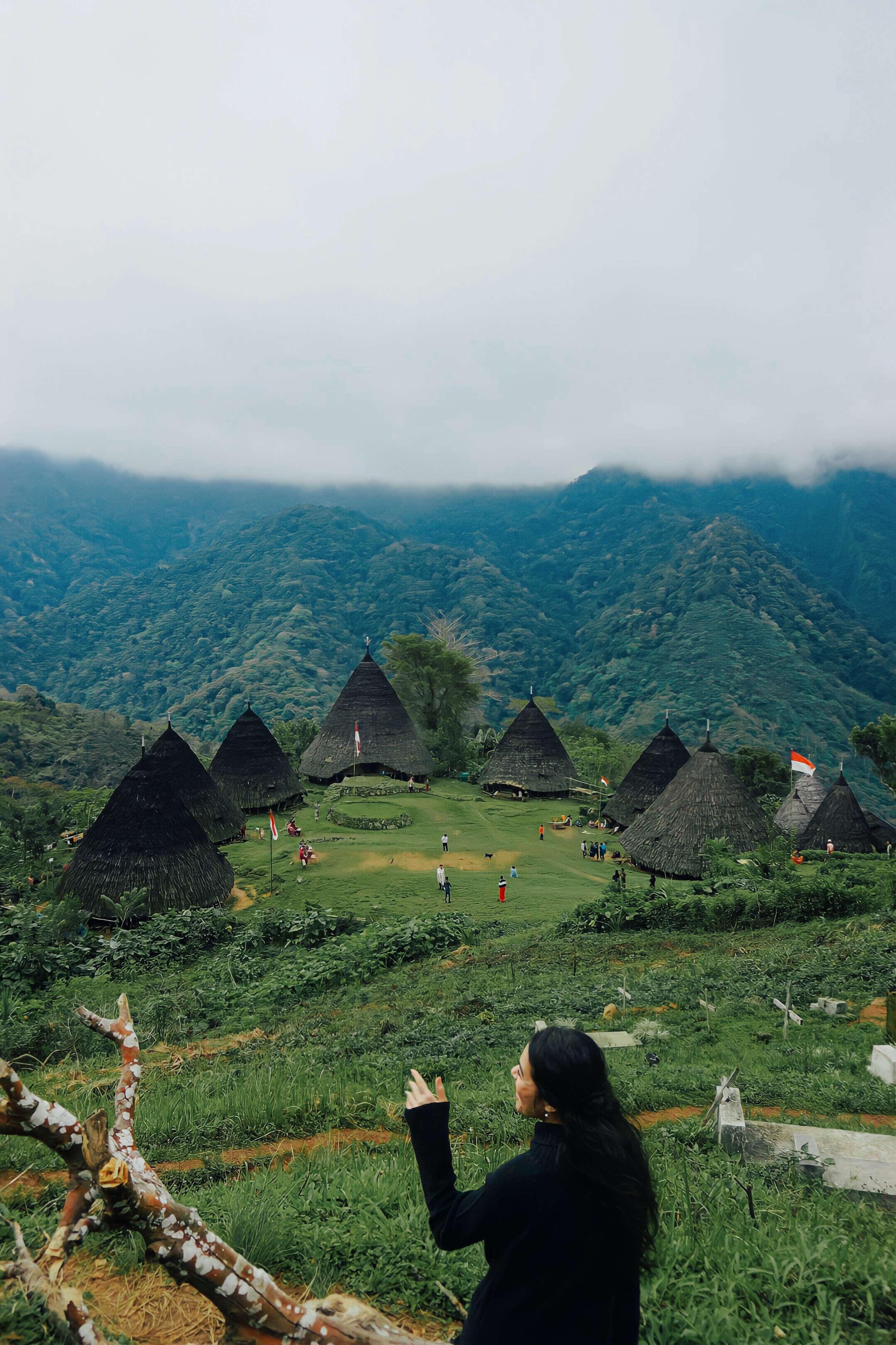
Maybe there are still many out there who don't know what this plant is.
Yep, this is Moringa leaves. Where Moringa is a plant that can grow quickly, live long, flower all year round, and is resistant to extreme heat conditions (in the tropics), Moringa can grow in the lowlands and highlands up to an altitude of 1,000 meters above sea level (m asl). Moringa leaves have many benefits for our health, one of which has excellent potential to complement the nutritional needs of the human body.
Talking about nutrition in today's era, especially in an era where most people really like instant food, without realizing how dangerous instant food is consumed every day. Therefore I suggest it would be better to consume more spices or vegetables such as Moringa leaves, Because Moringa leaves are rich in vitamins A, C, B1 (thiamin), B2 (riboflavin), B3 (niacin), B6 and Folate. In addition, the content of Moringa leaves is also rich in magnesium, iron.
Therefore, if we consume Moringa leaves, the balance of nutrients in our bodies will be fulfilled so that people who consume Moringa leaves will be helped to increase their energy and endurance.
"Don't wait for illness to start a healthy lifestyle. Cultivate a healthy life to prevent all diseases :)”
“Benefits of Moringa leaves for nutritional balance for the body”
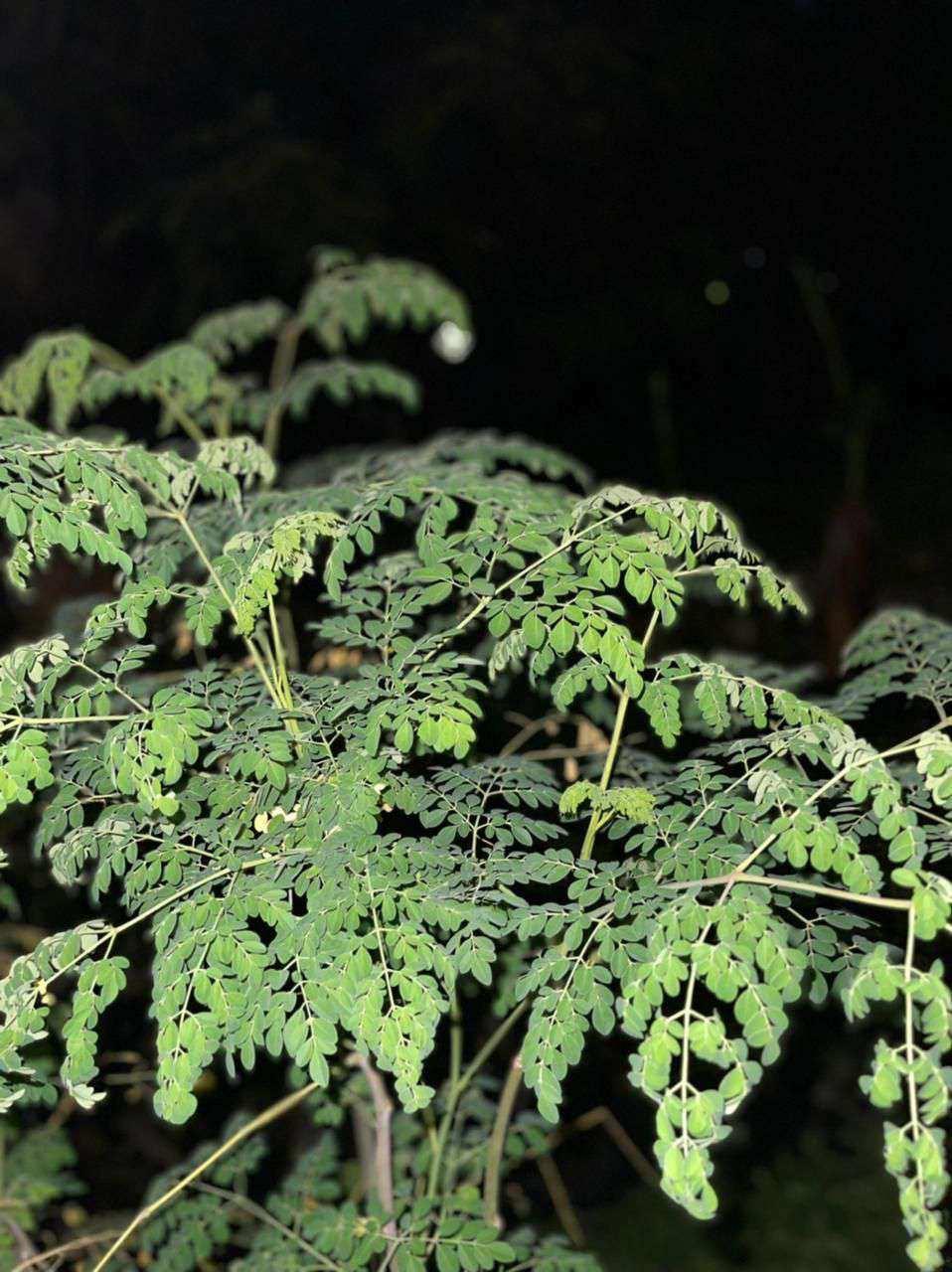
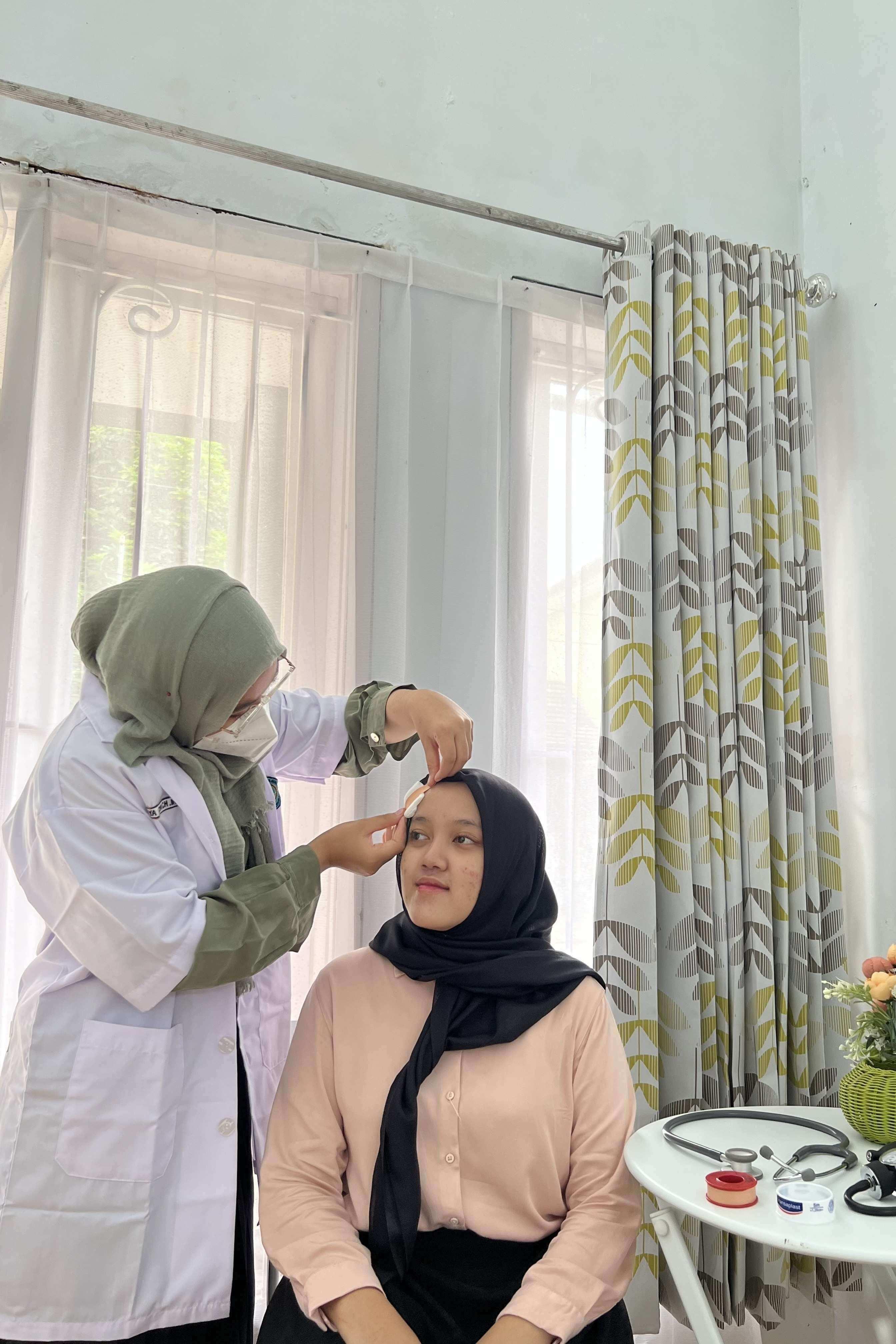

Pre-Conference Competition East Asian Medical Student’s Conference Nepal 2023 Infectious, Tropical, and Travel Medicine
Do Not Expose Yourself
Hasya
Hafiyan Tegar Hidayat
Correspondence E-mail: hasyahafiyan@gmail.com
Background
Tropical disease is an any disease that is indigenous to specifically occurs in those areas. The famous one is Dengue.
In some areas, the infection rate of DHF is high, therefore some precautions are needed for this.
Description & philosophy
DHF is caused by vector (usually a mosquito) that have preferrence to live in humid places such as in areas with high and dense grass. When traveling in these places, we need to wear full clothing, such as long sleeves and long pants to prevent mosquito’s bite. We can also apply chemicals such as mosquito repellent and need to bring a medkit to prevents worsening of symptoms.
Impact
Properly wearing long sleeves and long pants will prevent us from getting dengue disease and stop the spreading. By bringing our medkit, also includes a mosquito-repellant, we can be much relaxed knowing that we are decently protected when traveling in high-risk areas.
Conclusion
The spreading of dengue can be prevented in several ways, including by wearing longsleeved clothes and long pants and using mosquito-repellent chemicals. In addition, when traveling, it is also necessary to bring a medkit to sustain lives in case of medical emergency.
Keywords: Prevention, Infectious, Travel medicine, dengue
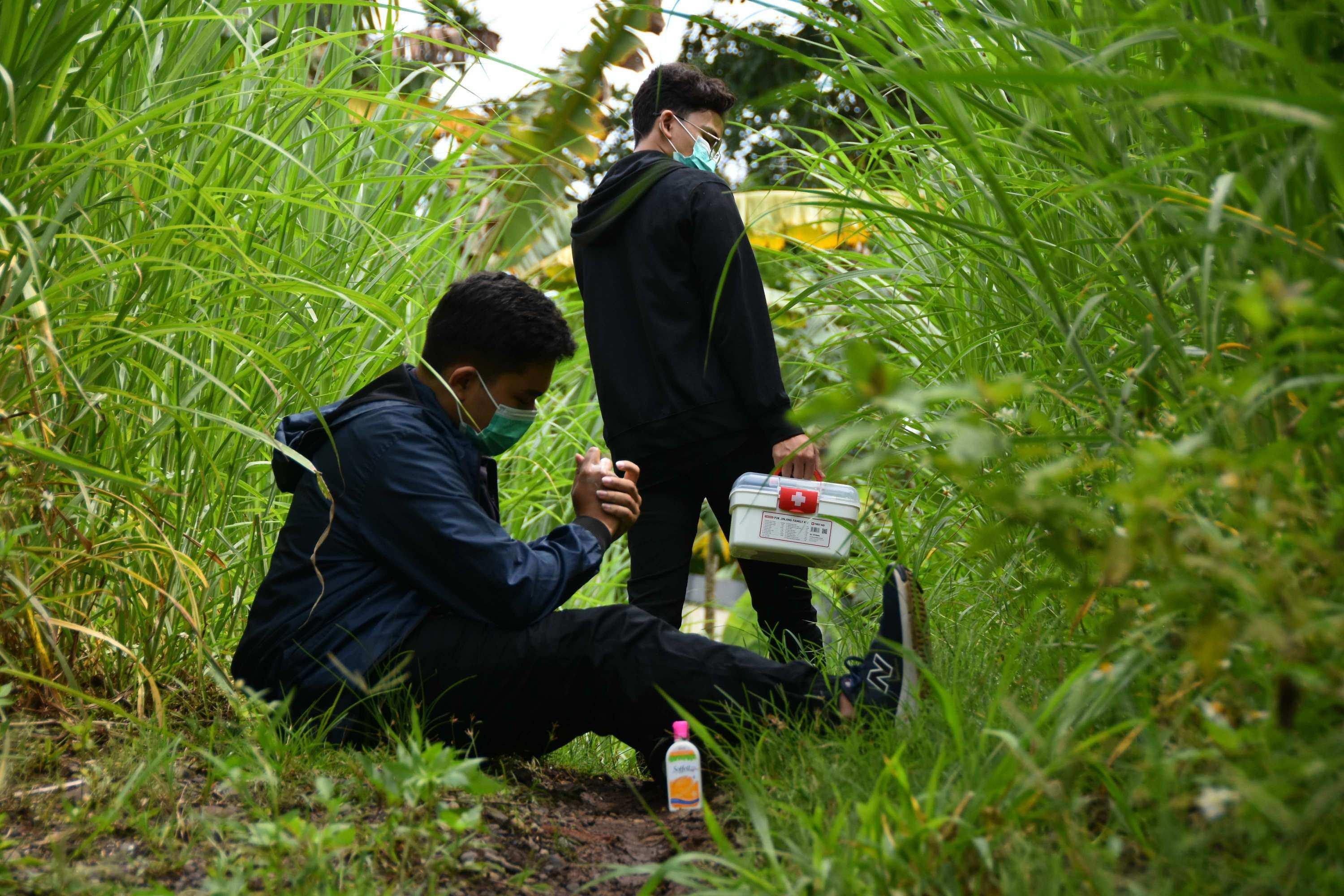
Four Pirates on Ascaris Discovery
October 22nd was a special date for four pilates was delighted by their discovery of a rare disease in the Island. One of a kind. This rare Soil Transmitted Helminth disease are actually have a high prevalence in Indonesia because of its tropical climate, whose overall prevalence was 33.8% with Ascaris lumbricoides. RSUD Dr Sutomo have given a command to discovers important thing in that island, taken froma stoolof a patient. There was a bunchofsteps before our success. It started with a strategy, by our Captain, called Direct Smear which required Lugol 1%, Eosin 1%, solution of P2, glass object and its cover. We used Lugol 1% onone side of the glass object and P2 on the other side. Using a stick, we made smear of stool to both side of glass object. After covering it with a cover, we analyze the preparation. Because of our dedication, we are proud to announce our discovery of Ascaris lumbricaides fertilized egg. RSUD Dr Sutomo are satisfied with our work.

Now What ?
366 out of 1000 mountaineers get frostbite annually. A man get a frostbite at the top of Butak Mountain (2.868 masl) in East Java cause he hike without proper equipment like jacket and glove. Lot of mountaineer underestimate the importance of a “proper” equipment like glove, jacket, and shoe. Human tend to crave for their desire without considering their own safety matter and they won’t see the consequences of their omission until they fulfill their desire. Yes, he get to conquer on of the great mountain in East Java, and yes, he get to the peak and highest point of the city of Batu. But at what cost ? So, now what ?
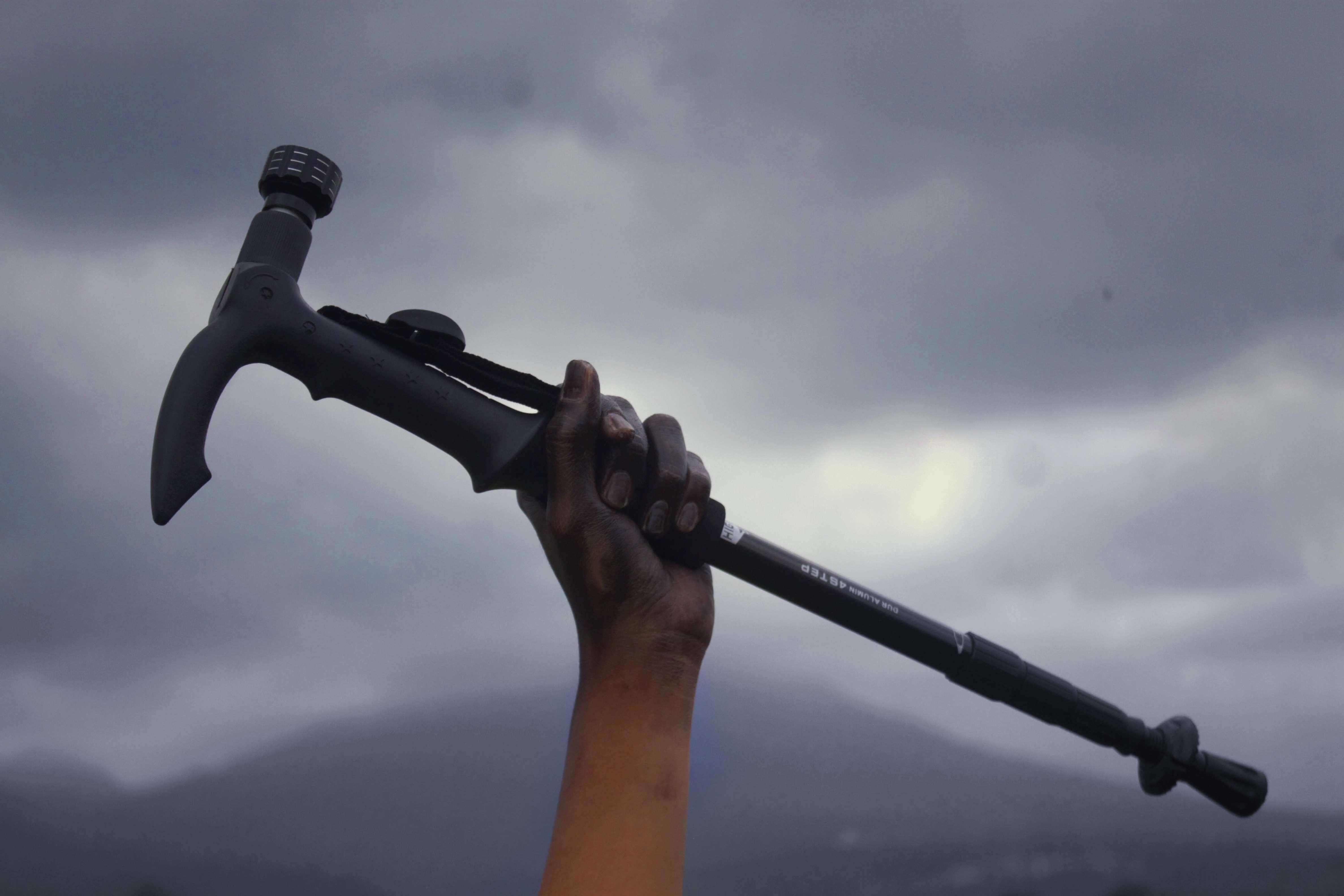
Healer's Stigma: Unlock Cures Better
Nathalia Angelina
As seen in the picture, snakebite is a major public health problem and serious envenomation can be responsible for considerable morbidity and mortality if not treated correctly. Among the world's largest tropical regions, Indonesia was particularly plagued by snakebites. Snakebites are highly prevalent, and treatments for snakebites already exist, yet snakebites are one of the world's biggest hidden health crises. Thus, victims often seek out traditional remedies or seek out traditional healers as a first step toward healing. Proudly, showed a holistic approach to treatment as a healer can practice with Herbal Shamans vs Medical Healthcare. Early ancestors often used the natural surroundings (from various types of plants) as medicine but according to medical healthcare, prophylactic antibiotics can cure snake bites from venomous snakes. What's better?... As shown in the photo, unlocking the best integrative medicine can combine medical healthcare knowledge with other such herbal shamans as alternative practices that are evidence-based and safe.

Evacuation Route
Beyondthebeautyofwildscenery,therearesomethreatsthatcanthreatenexplorers.Unwanted thingssuchasmedicalemergenciesandnaturaldisasterscanoccurwhileexploring.In addition to first aid, we must also know where we should go.
evacuationroutesareveryimportantinthesecircumstances.Whenpanickingwecanmove to thewrongpathandendangerourselves.evacuationroutesmustbewellunderstoodbyexplorers sothateverythingcanbehandledproperly.Whateverhappens,don'tpanicandmovetothe evacuation route !!
AltercatingAltitude
To move one’s limit, would nature and senses coalesce?


Theme : Mountain and Wilderness Medicine
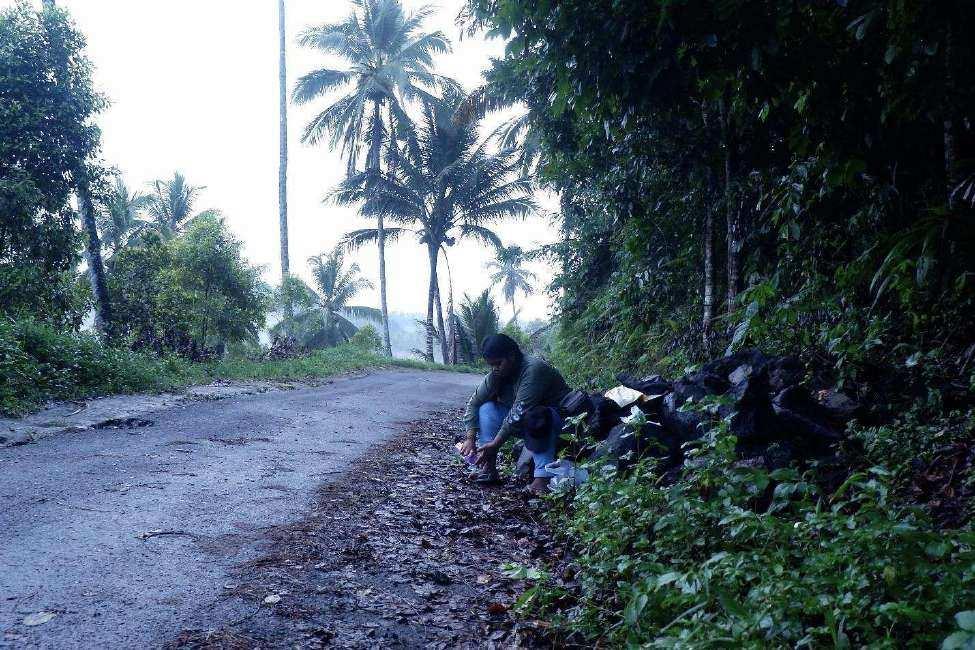
Sub theme : Trauma, First-Aid, and Wound Care
Name : Michael H. Pitoy (AMSA-Universitas Sam Ratulangi)
“FIRST-AID IN HIKING INJURIES”
Hiking is indeedoneofthemost enticing activitiesforadventurers.Roamingthroughthemountain and wilderness can provide great views of nature and tingle that sense of excitement in individuals. Not only that, the unpredictable terrain also poses challenges and threats, such as trauma and injuries.
Along with ankle sprains and broken bones, a few of the most common hiking injuries include scrapes, blisters, and cuts to the human body. Individuals tend to leave injuries like that untreated, especially iftheyaresmall andunnoticeable,without knowingthatthoseinjuries canleadto severe infections if left untreated. Not giving the proper first-aid treatment can also delay the healing process of an injury. In this picture, it can be seen a hiker taking a break to treat a wound on her foot by cleaning it with clean water before applying topical antibiotics to prevent infections.




























































